Japandi design offers a serene and sophisticated approach to bathroom interiors, blending the rustic minimalism of Scandinavian style with the timeless elegance of Japanese aesthetics. This hybrid style emphasizes clean lines, natural materials, and a deep appreciation for craftsmanship and functionality. The result is a tranquil, uncluttered sanctuary that promotes relaxation and mindfulness. By focusing on a neutral color palette, organic textures, and thoughtfully selected decor, a Japandi bathroom becomes more than just a functional space; it transforms into a personal retreat. This approach prioritizes quality over quantity, creating a balanced and harmonious environment that feels both modern and warm.
1. Japandi Bathroom with a Floating Oak Vanity
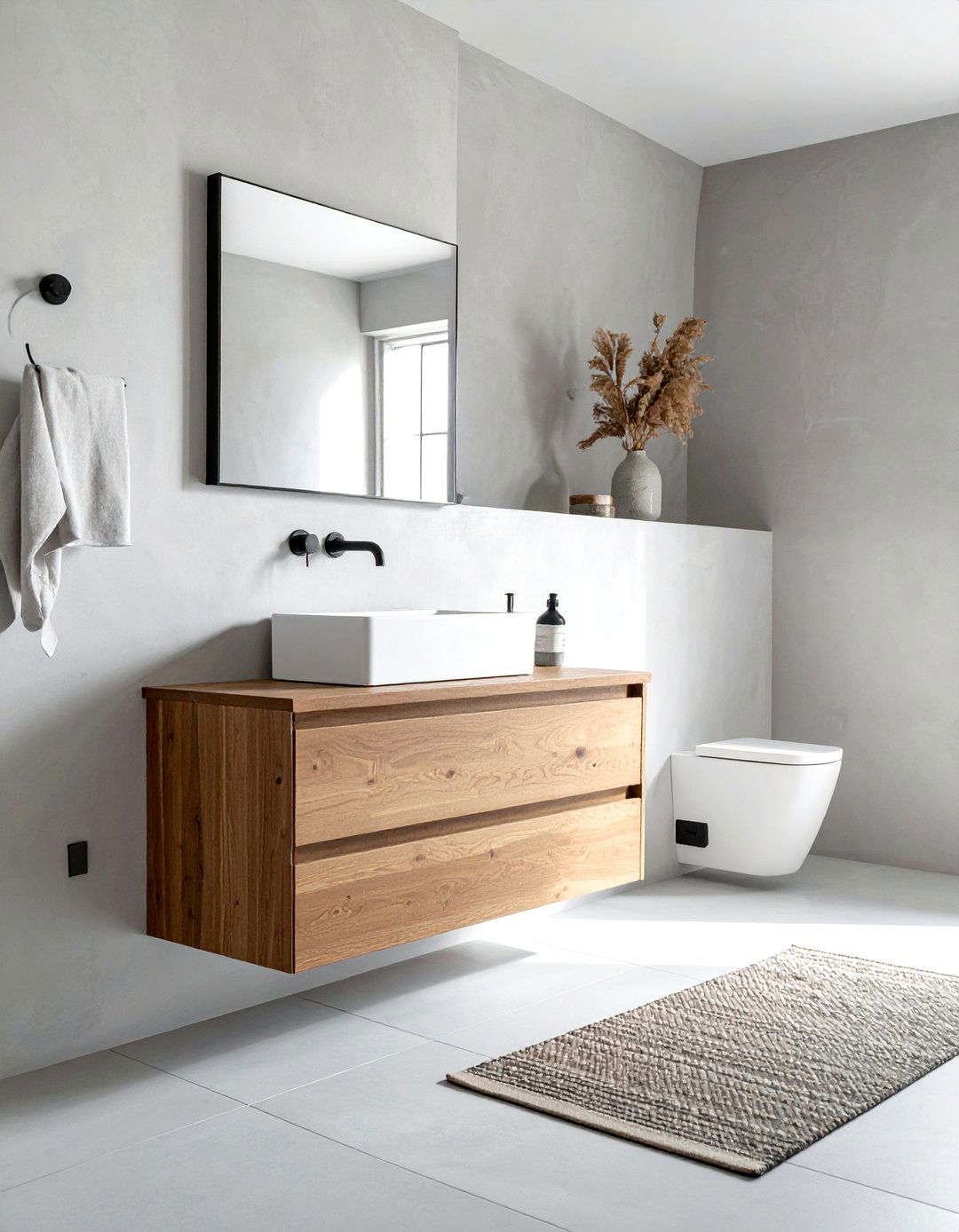
A floating oak vanity is a cornerstone of Japandi bathroom design, creating an illusion of spaciousness while adding organic warmth. This minimalist piece, crafted from light or medium-toned oak, features clean lines and handle-less drawers to maintain an uncluttered profile. By mounting it to the wall, you free up floor space, which enhances the room's airy and open feel. This functional choice not only provides essential storage but also serves as a beautiful focal point. Pairing it with a simple vessel sink and matte black or brushed brass fixtures completes the look, perfectly balancing Scandinavian functionality with Japanese simplicity and a deep respect for natural materials.
2. Japandi Bathroom with Concrete Countertops
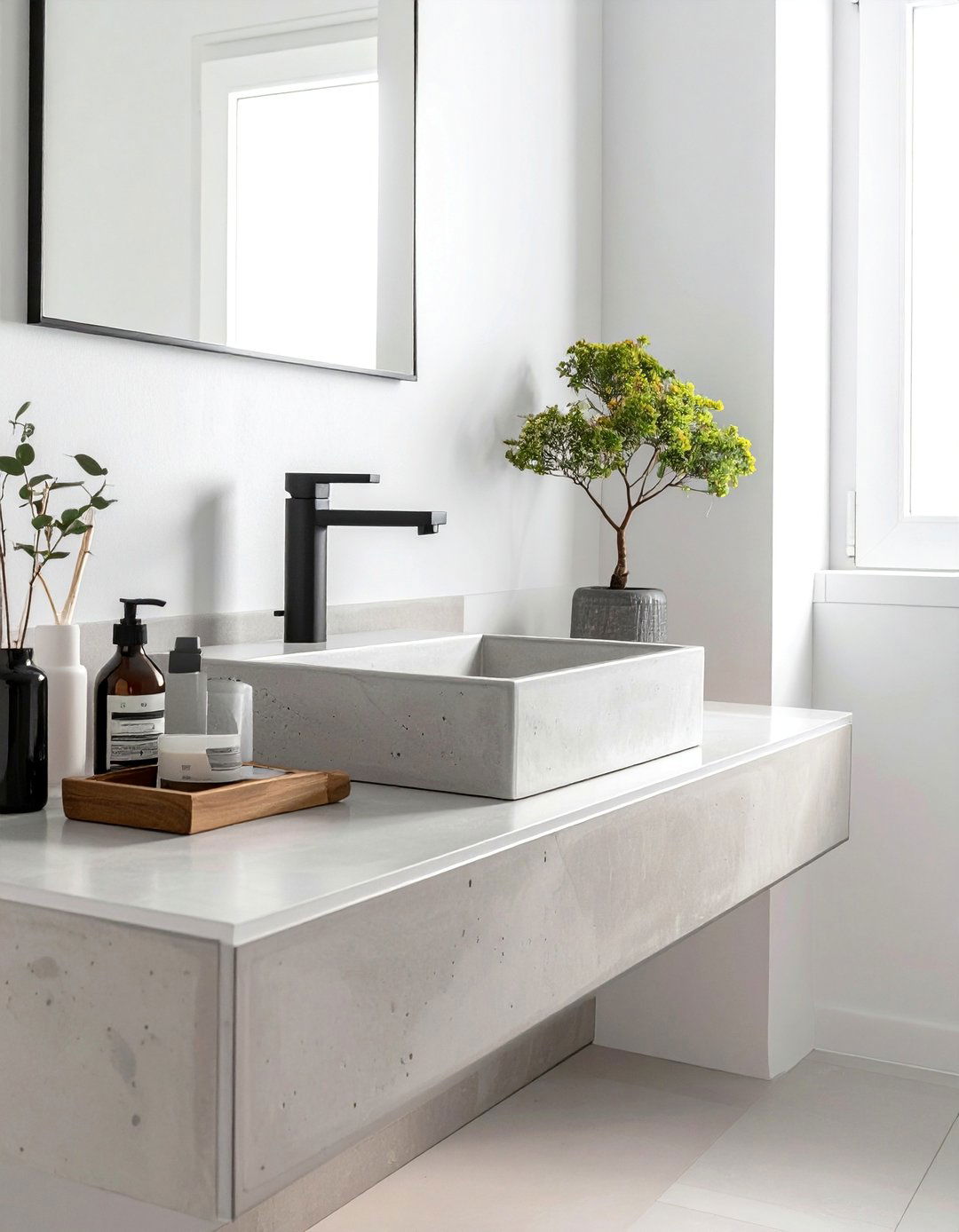
For a touch of wabi-sabi imperfection, consider incorporating concrete countertops into your Japandi bathroom. The raw, textured surface of concrete introduces an earthy, industrial element that contrasts beautifully with the warmth of wood accents. Its subtle variations in color and texture celebrate the Japanese aesthetic of finding beauty in imperfection. This durable and minimalist material offers a sleek, seamless surface that is both practical and visually striking. When paired with a simple ceramic sink and minimalist fixtures, concrete countertops help ground the space, adding a layer of depth and character that feels both modern and timelessly elegant, enhancing the overall serene atmosphere.
3. Japandi Bathroom with Shoji Screen-Inspired Shower Doors
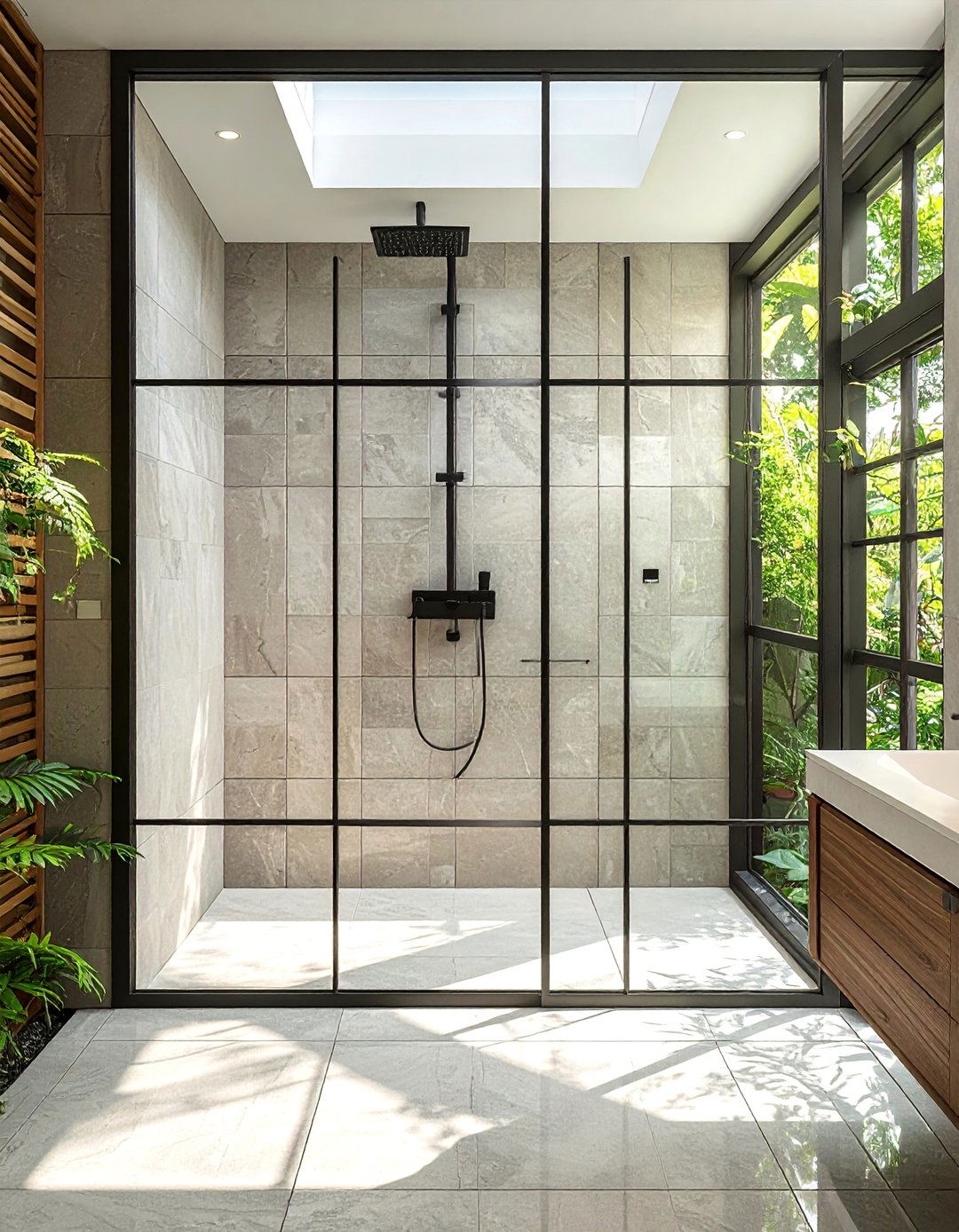
Bringing the essence of Japanese architecture into your bathroom, shoji screen-inspired shower doors offer a unique way to divide space while maintaining a light, airy feel. These doors typically feature frosted or translucent glass panels set within a minimalist wood or black metal frame, mimicking the traditional paper screens. This design choice allows light to filter through, brightening the shower area without sacrificing privacy. The clean, geometric lines of the frame add a structural element that aligns perfectly with both Japanese and Scandinavian design principles. This functional art piece transforms a standard shower into a serene, spa-like enclosure that elevates the entire bathroom's aesthetic.
4. Japandi Bathroom with a Hinoki Wood Soaking Tub
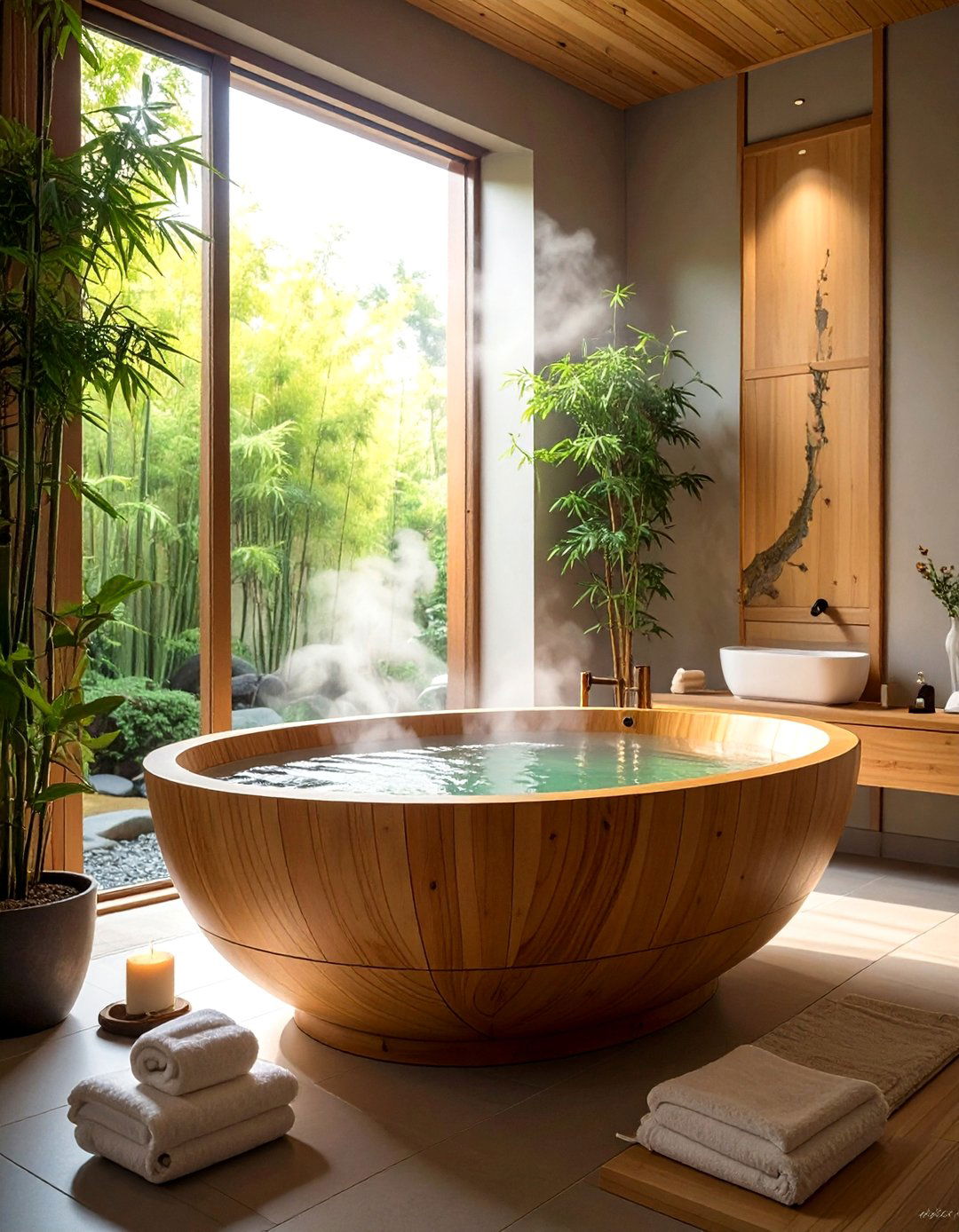
An ofuro, or traditional Japanese soaking tub, made from Hinoki wood, is the ultimate expression of tranquility in a Japandi bathroom. This type of tub is deeper than Western models, designed for upright, contemplative soaking rather than reclining. The Hinoki wood itself is highly prized for its rich grain, resistance to humidity, and its calming, lemony fragrance that is released when wet, enhancing the spa-like experience. Its simple, unadorned construction highlights the natural beauty of the material, making it a stunning centerpiece. Placing this tub in a light-filled corner creates a dedicated space for relaxation and mindfulness, epitomizing the Japandi focus on well-being.
5. Japandi Bathroom with Textured Plaster Walls
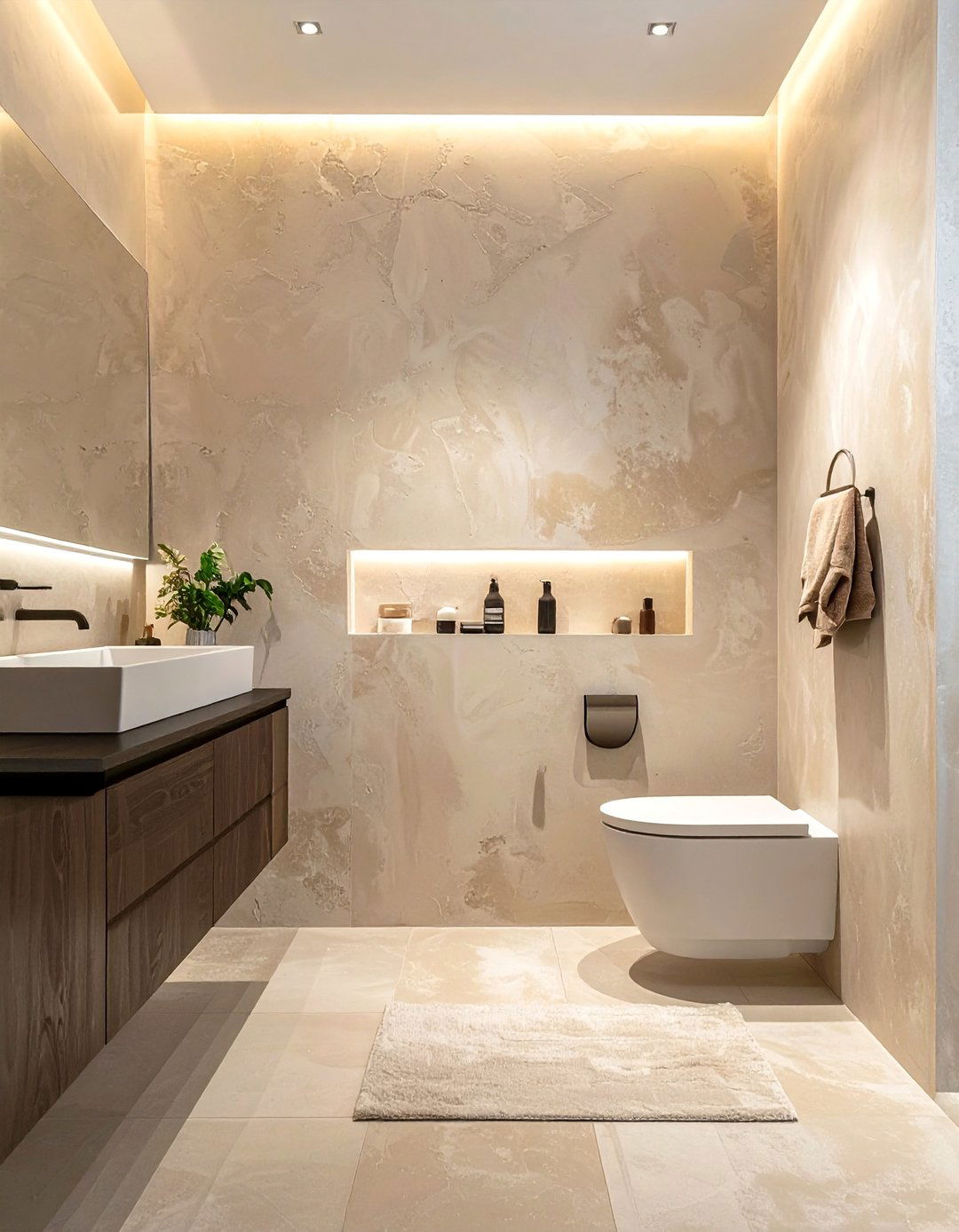
To introduce subtle depth and a tactile quality, use textured plaster walls in your Japandi bathroom. Finishes like tadelakt or limewash create a soft, matte surface with gentle, cloud-like variations in tone. This application moves away from flat, painted walls, embracing the wabi-sabi philosophy of appreciating natural textures and imperfections. The organic, handcrafted feel of plaster adds warmth and character without overwhelming the minimalist aesthetic. It provides a serene, neutral backdrop that beautifully complements natural materials like wood and stone. This choice enhances the room's sensory experience, making the space feel both grounded and sophisticated, inviting a sense of calm and tranquility.
6. Japandi Bathroom with Matte Black Fixtures
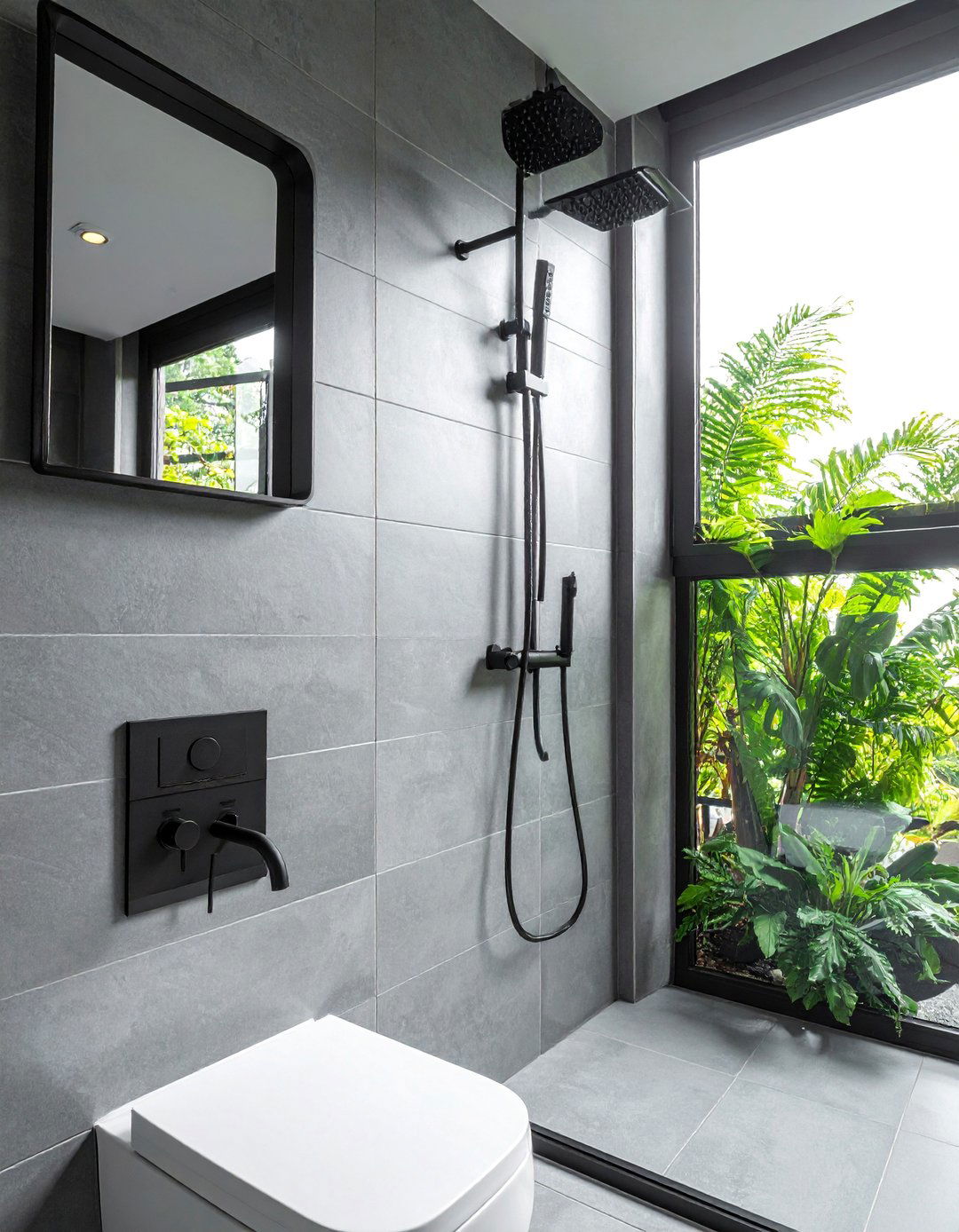
Matte black fixtures provide a bold yet sophisticated contrast in a Japandi bathroom. The sharp, clean lines of a black faucet, showerhead, and towel rails stand out against a backdrop of neutral tones and natural materials like light wood and stone. This choice introduces a modern, Scandinavian-inspired element that grounds the space and adds a touch of graphic definition. Unlike polished chrome, the matte finish is understated and doesn't create distracting reflections, contributing to the room's overall sense of calm. These fixtures pair seamlessly with both minimalist and rustic elements, tying the Japanese and Scandinavian aesthetics together in a cohesive and visually striking way.
7. Japandi Bathroom with Bamboo Elements
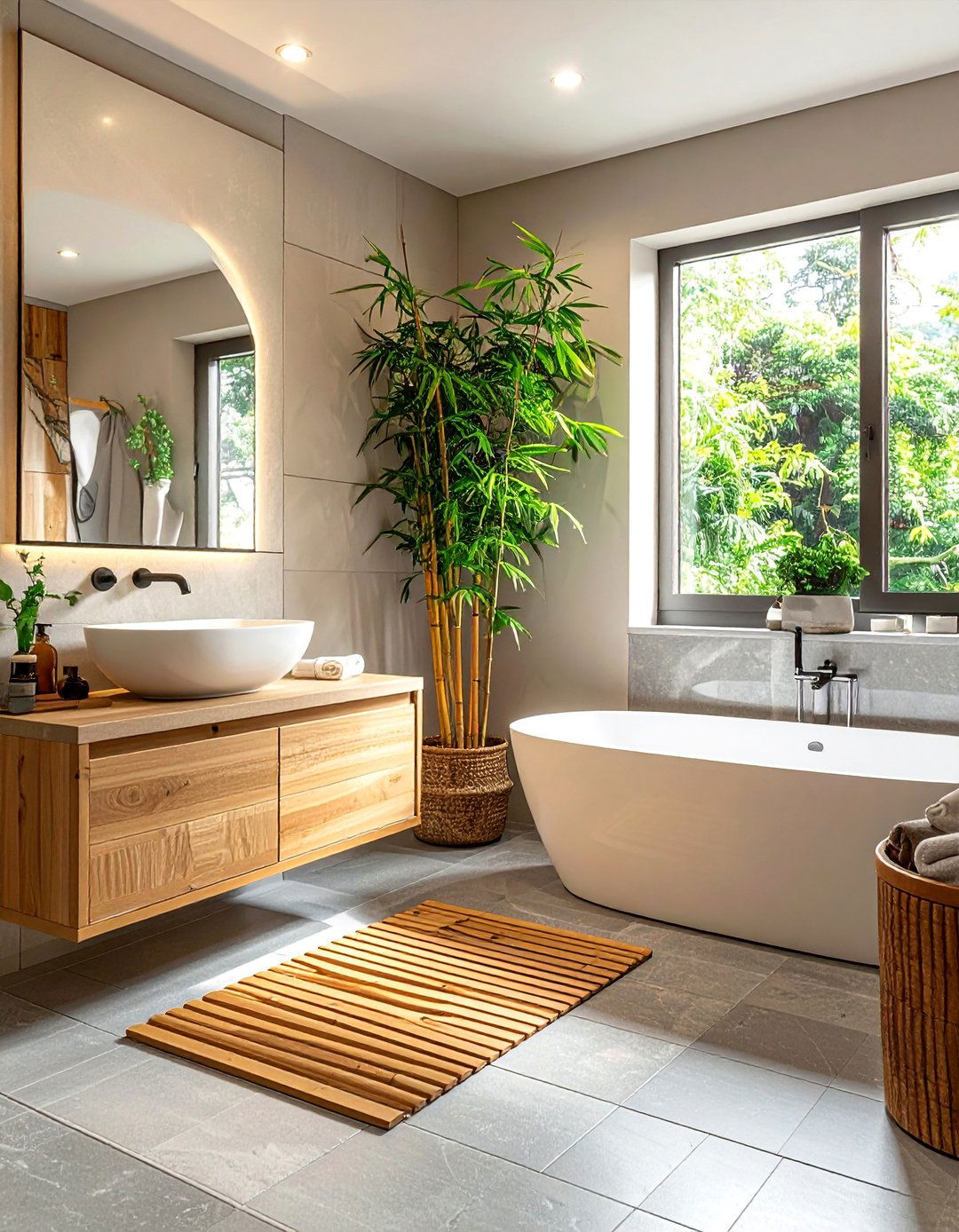
Incorporating bamboo is an excellent way to infuse a Japandi bathroom with a sustainable and organic touch. Use bamboo for a bathmat, a storage ladder for towels, or small accessories like soap dispensers and trays. This fast-growing grass is not only eco-friendly but also naturally water-resistant, making it ideal for a humid environment. Its light color and distinct grain pattern add visual interest and texture without disrupting the minimalist calm. Bamboo’s connection to traditional Japanese design lends an authentic feel to the space, while its simplicity aligns with Scandinavian functionalism. These elements bring a piece of nature indoors, reinforcing the connection to the outdoors.
8. Japandi Bathroom with Slate Tile Flooring
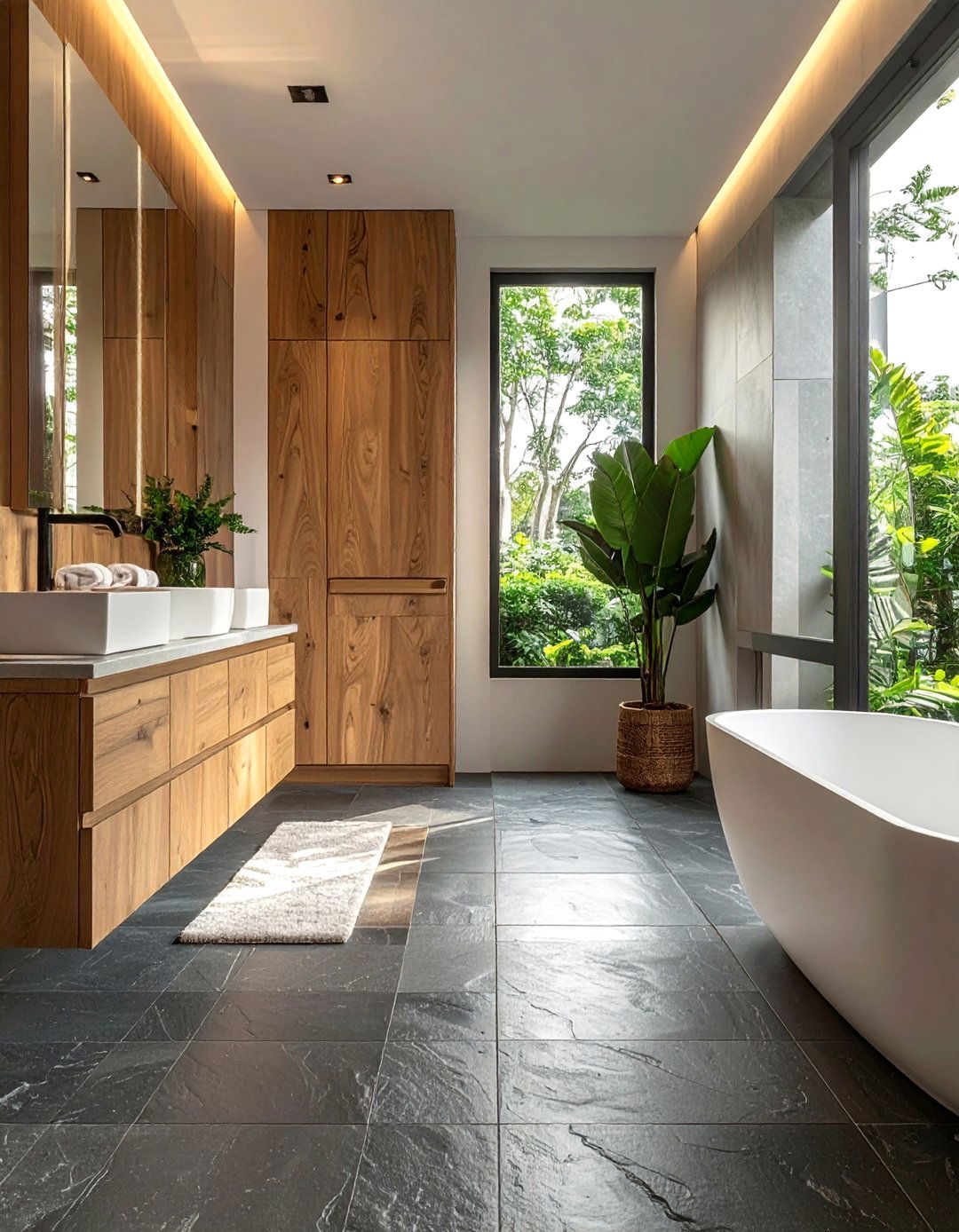
Slate tile flooring introduces a rich, natural texture and a grounding element to a Japandi bathroom. The deep, earthy tones of slate, ranging from dark gray to muted green, create a dramatic yet calming foundation for the room. Its naturally uneven surface provides a tactile experience underfoot and adds a layer of wabi-sabi imperfection that is central to Japanese design. This durable material is also practical for a bathroom, offering slip resistance and easy maintenance. Paired with light wood cabinetry and crisp white walls, slate flooring provides a beautiful contrast that enhances the minimalist aesthetic while adding a sense of organic, timeless elegance to the overall design.
9. Japandi Bathroom with Integrated LED Lighting
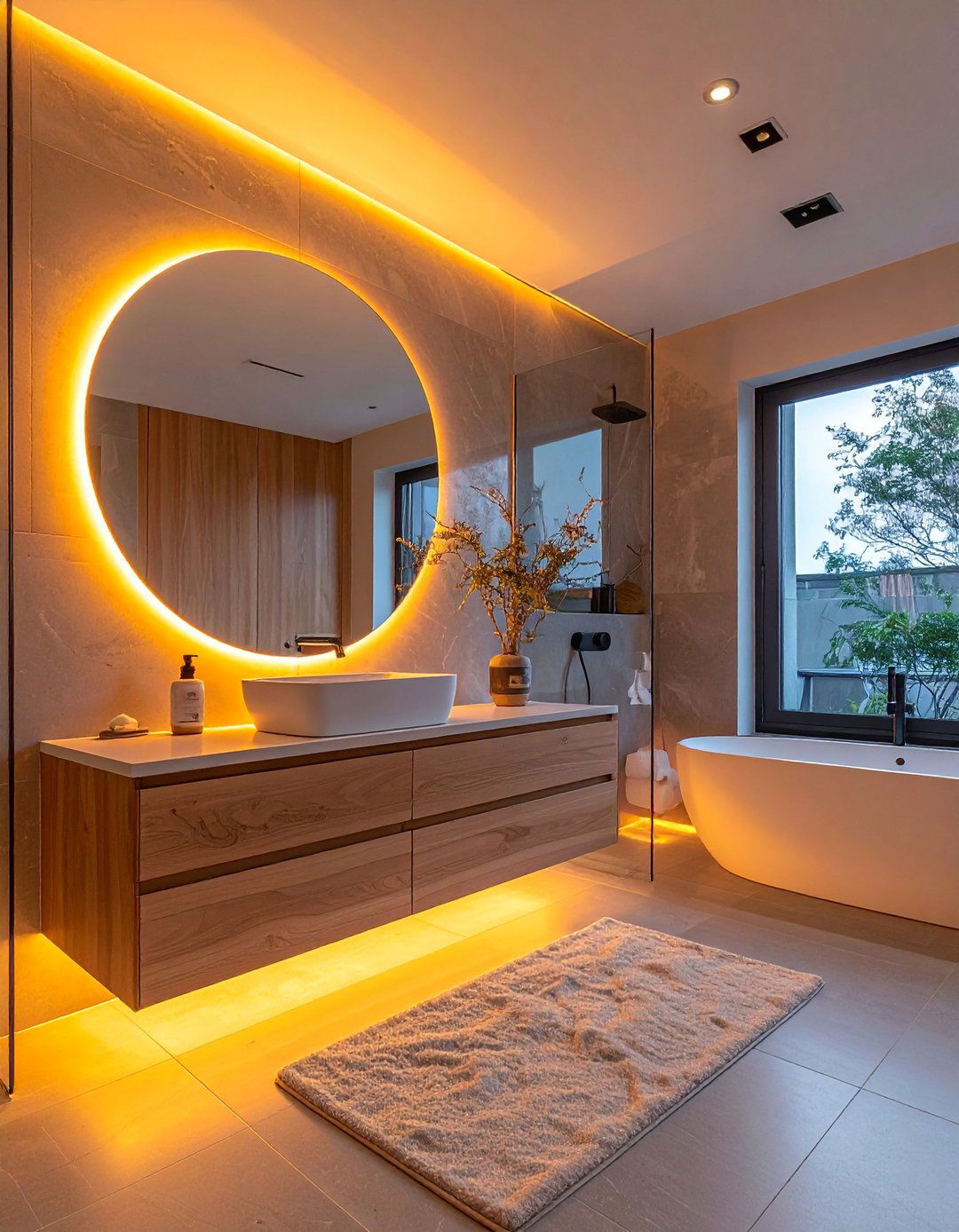
Subtle, integrated LED lighting is key to creating a serene and functional Japandi bathroom. Instead of harsh overhead lights, consider installing hidden LED strips behind a mirror, under a floating vanity, or within a recessed wall niche. This technique, known as accent lighting, washes the walls with a soft, diffused glow that eliminates shadows and creates a calming ambiance. It highlights the textures of materials like wood and stone while maintaining an uncluttered look. Dimmable options allow you to adjust the brightness to suit your mood, whether you're getting ready in the morning or unwinding in the evening, perfectly blending modern technology with minimalist design.
10. Japandi Bathroom with Minimalist Floating Shelves
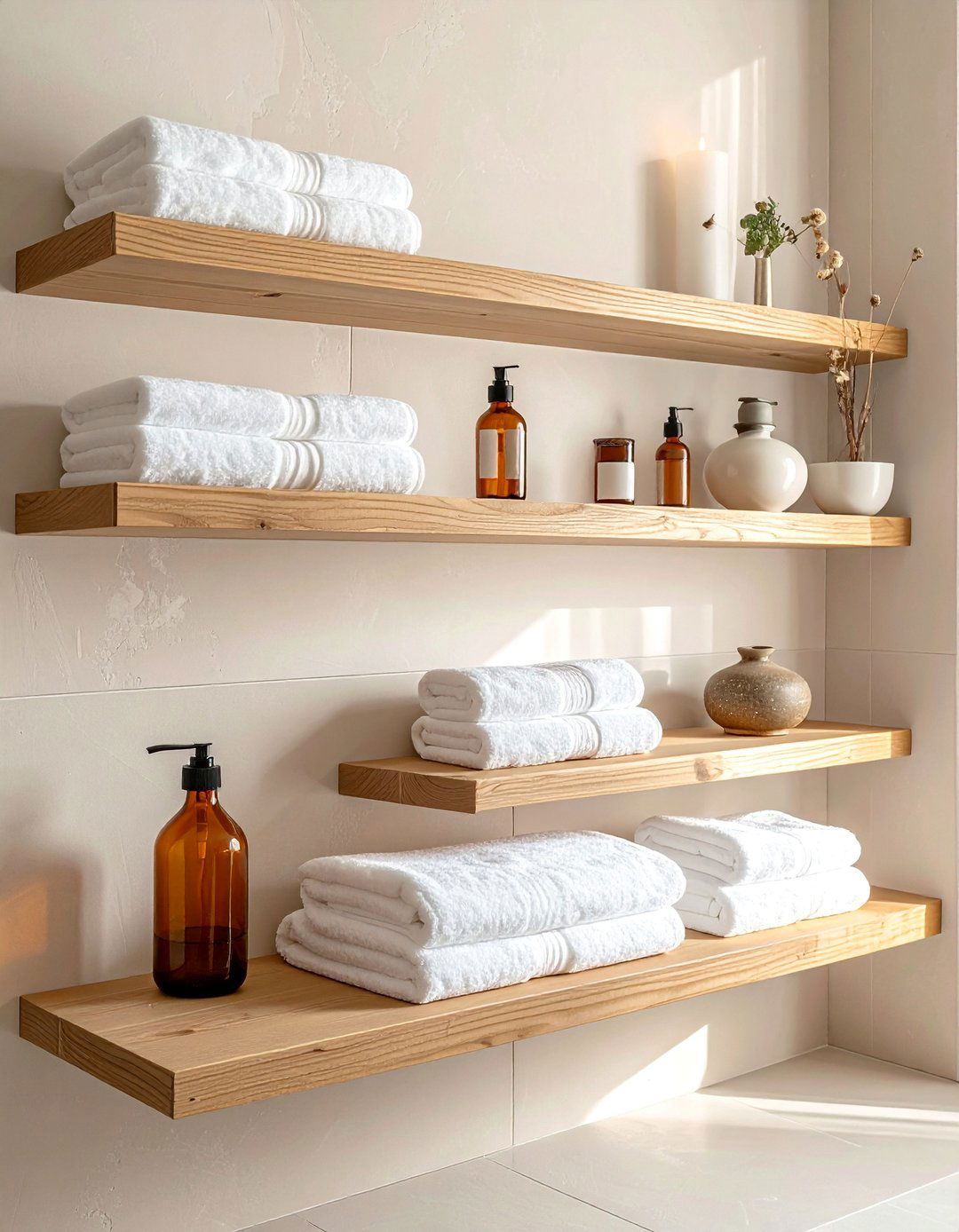
Minimalist floating shelves, particularly those made from light-grained wood like oak or birch, are a perfect storage solution for a Japandi bathroom. These shelves maintain the open, airy feel of the space while providing a platform for carefully curated essentials and decor. Arrange them with a few neatly folded towels, a small plant, and perhaps a ceramic vase or a bottle of artisanal soap. The key is to avoid clutter and display only what is beautiful or necessary. This approach combines Scandinavian practicality with the Japanese principle of 'ma', which values negative space. The result is a storage solution that is both functional and aesthetically pleasing.
11. Japandi Bathroom with Large-Format Wall Tiles
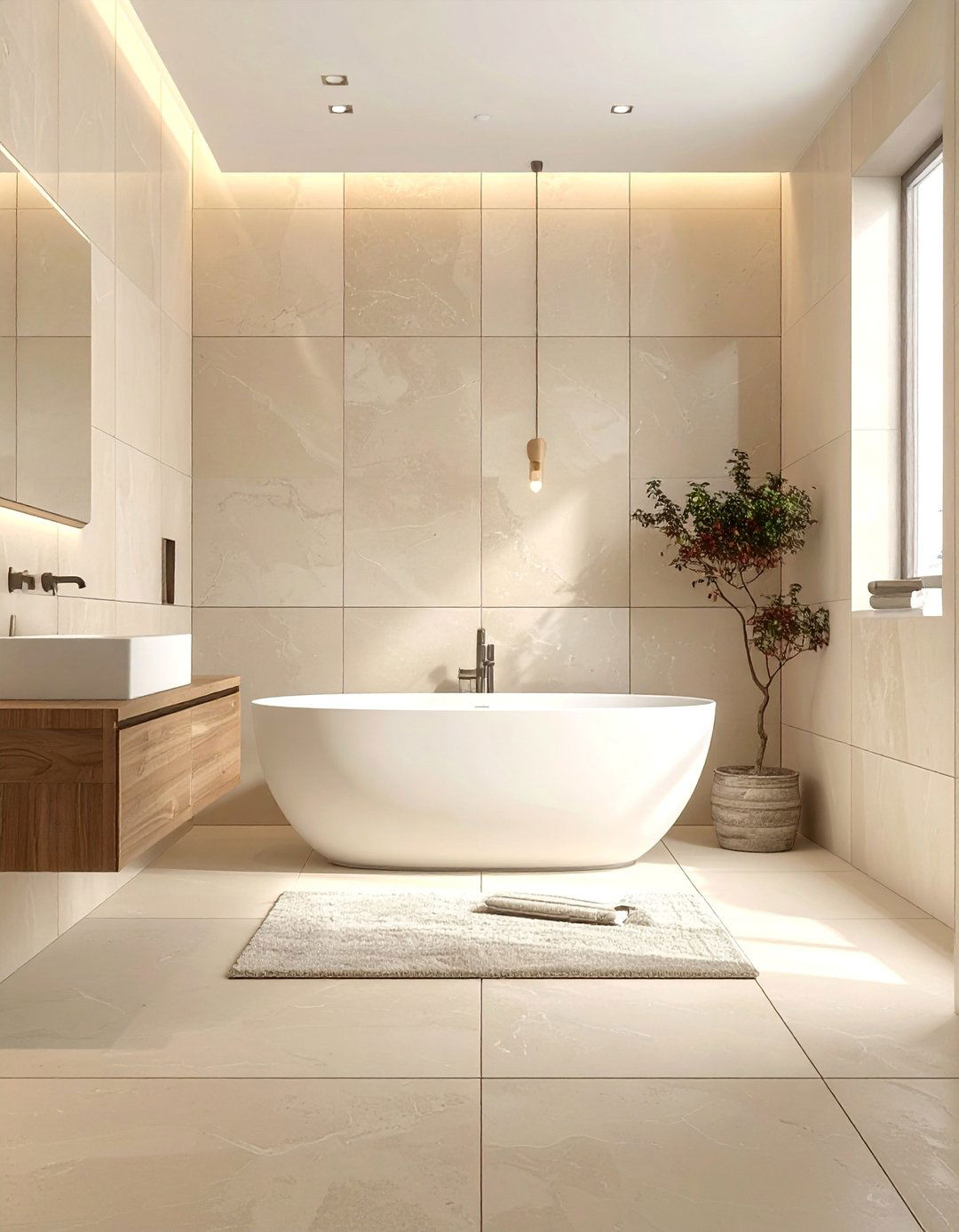
Using large-format tiles on the walls of a Japandi bathroom creates a seamless and serene backdrop. With fewer grout lines, these oversized tiles in neutral shades like beige, light gray, or off-white contribute to an uncluttered and expansive feel. This minimalist approach draws attention to the texture and subtle color variations of the tiles themselves, whether they have a matte concrete look or a soft stone finish. The clean, continuous surface enhances the sense of space and tranquility, making it an ideal choice for both small and large bathrooms. It provides a perfect canvas to highlight other natural elements, such as a wooden vanity or stone accessories.
12. Japandi Bathroom with Organically Shaped Mirrors
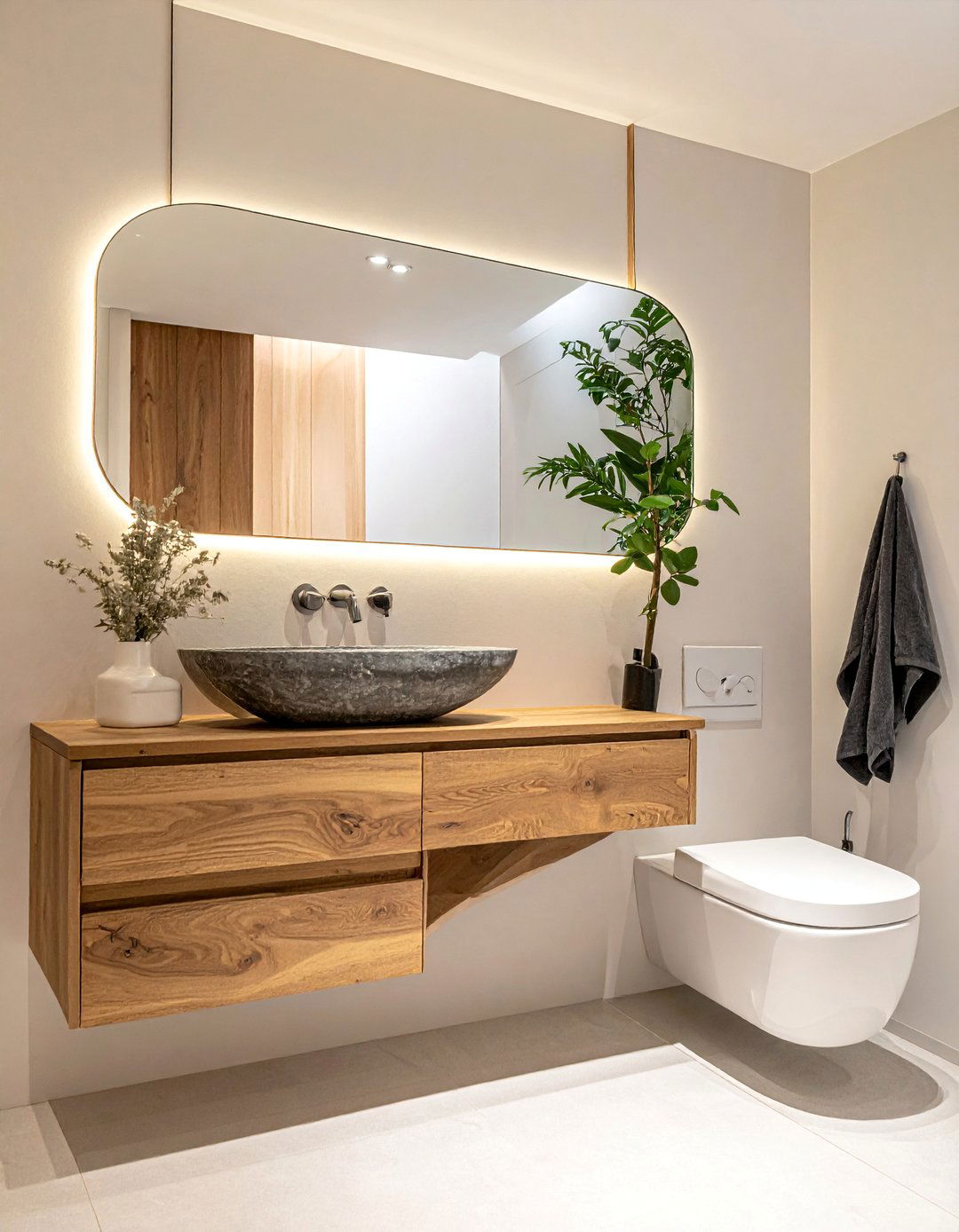
Move away from sharp, geometric shapes by introducing an organically shaped mirror into your Japandi bathroom. An asymmetrical or pebble-shaped mirror softens the clean lines typical of minimalist design, adding a gentle, natural flow to the space. This subtle departure from convention introduces a sculptural element that feels both artistic and understated. A frameless design keeps the look clean, while a thin, minimal frame in black or wood can help tie it in with other fixtures or cabinetry. This simple yet impactful choice breaks up the rigidity of the room, reflecting the Japanese appreciation for the imperfect, organic forms found in nature.
13. Japandi Bathroom with a Neutral Earth-Tone Palette
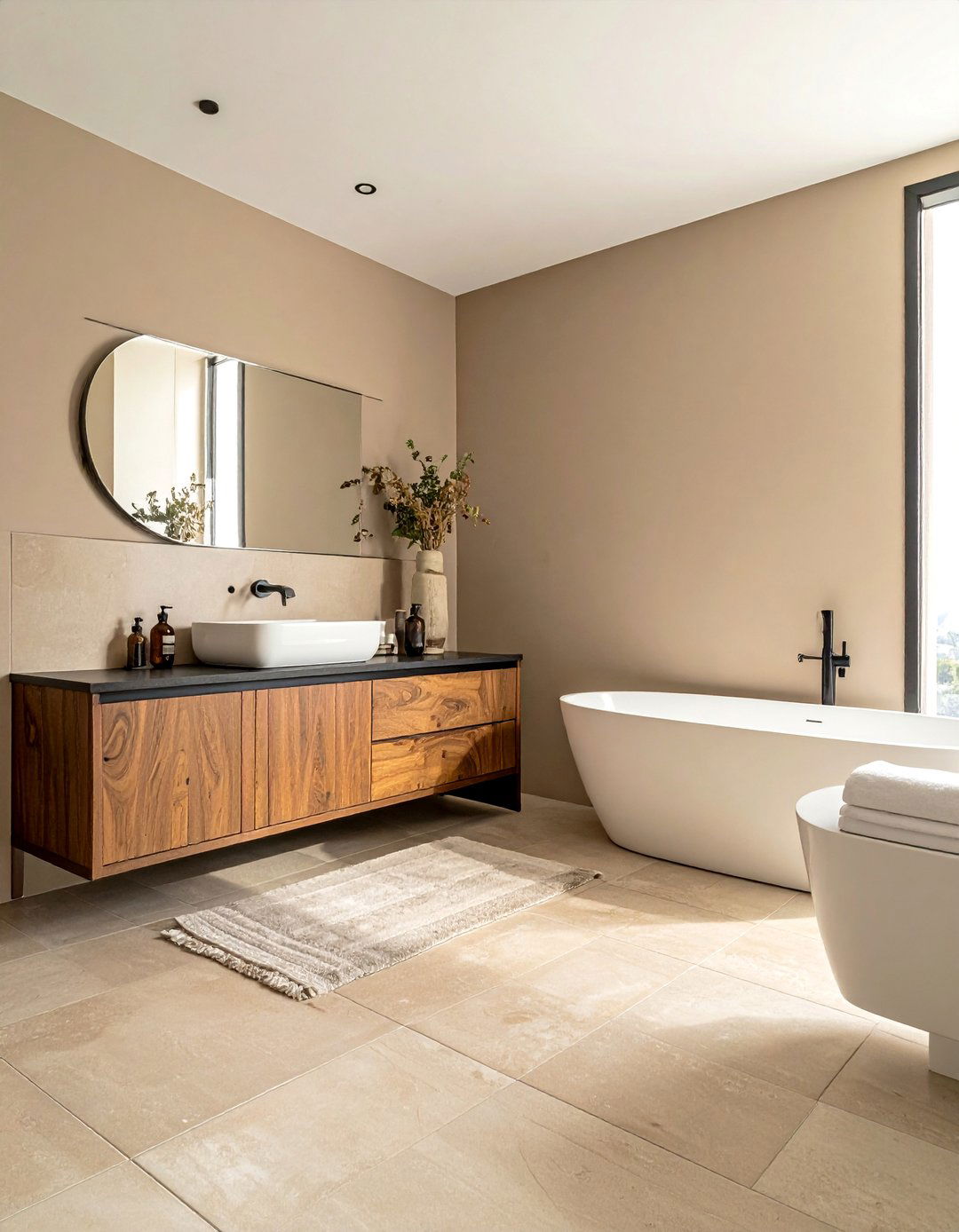
A neutral, earth-toned color palette is fundamental to achieving the Japandi aesthetic. Focus on shades of beige, taupe, mushroom, and soft gray, complemented by warm whites and deep, grounding tones like charcoal or muted brown. This palette, inspired by nature, creates a calming and harmonious atmosphere that promotes relaxation. These colors serve as a serene backdrop for natural materials like wood, stone, and bamboo to stand out. By layering different tones and textures within this limited palette, you can create a space that is rich in depth and visual interest without feeling busy or overwhelming, perfectly capturing the essence of minimalist tranquility.
14. Japandi Bathroom with a Statement Freestanding Tub
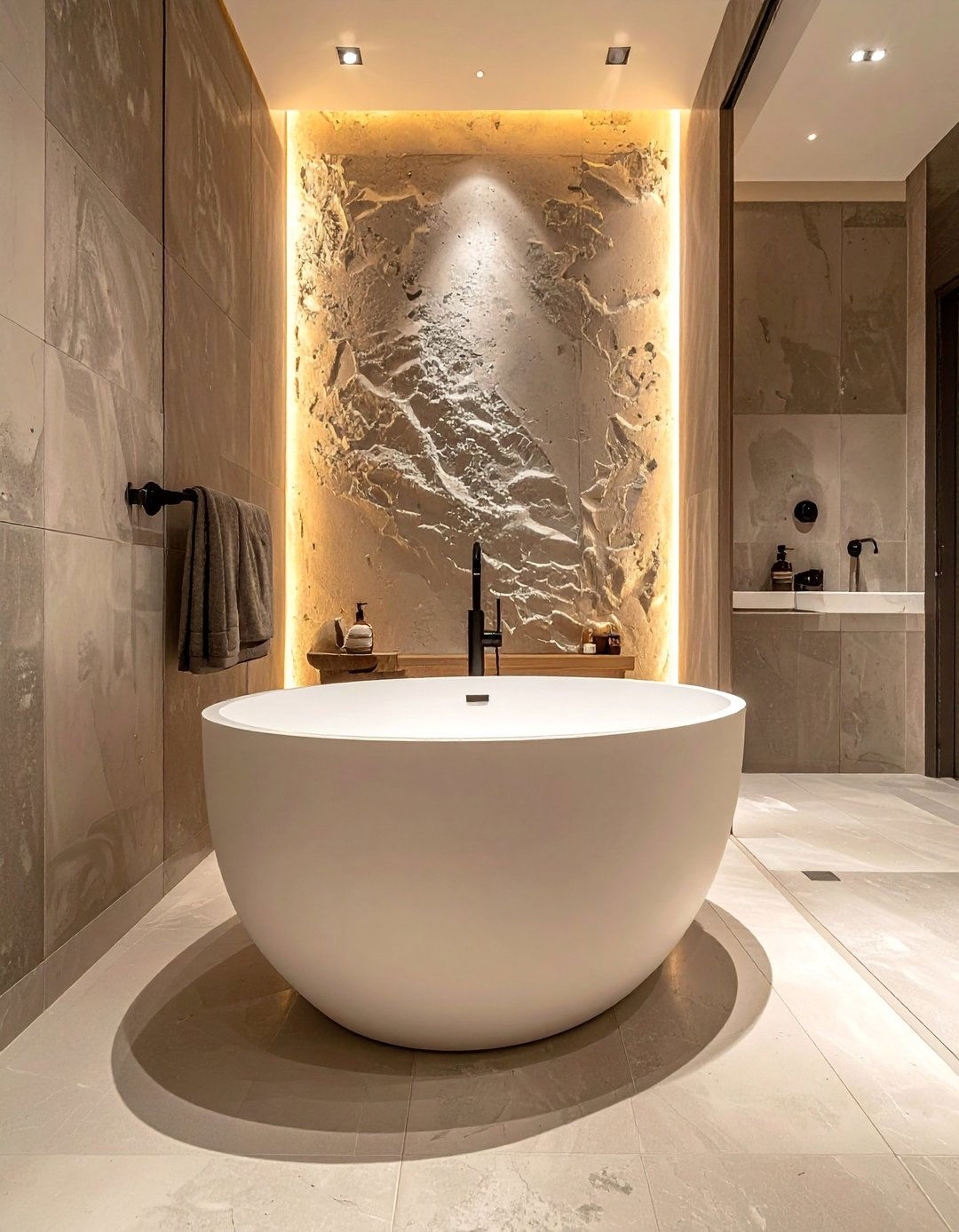
A statement freestanding tub serves as a stunning focal point in a Japandi bathroom. Opt for a tub with a simple, sculptural silhouette, crafted from materials like matte solid surface or stone resin. Its clean lines and unadorned form embody minimalist elegance, inviting you to relax and unwind. Unlike built-in tubs, a freestanding model creates a sense of openness and luxury. Position it near a window to connect with natural light and outdoor views, enhancing the tranquil experience. This single, impactful piece perfectly balances form and function, embodying the Japandi philosophy of investing in high-quality, beautiful items that elevate everyday routines into mindful rituals.
15. Japandi Bathroom with Thoughtfully Placed Greenery
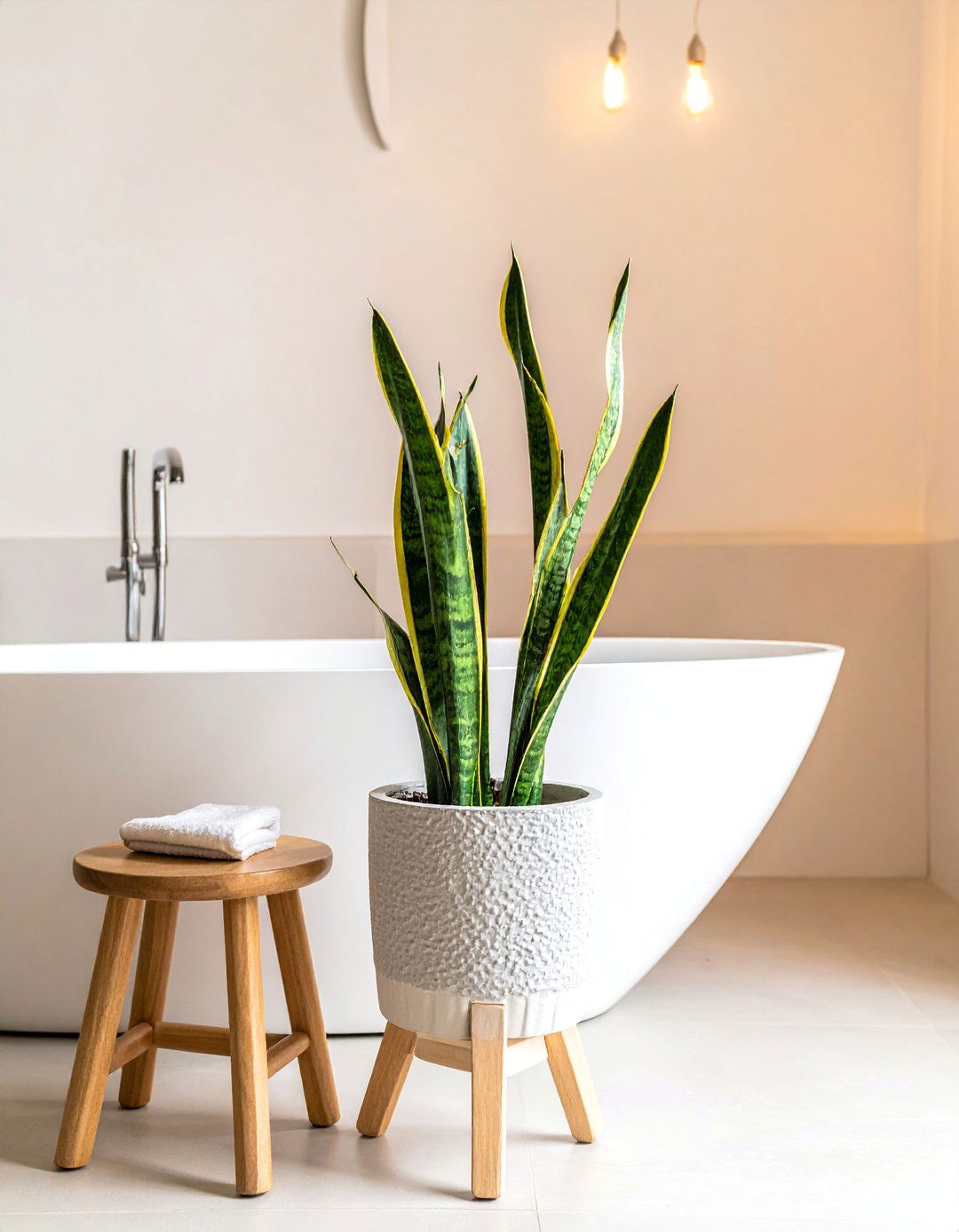
Introducing thoughtfully placed greenery is essential for bringing life and a connection to nature into a Japandi bathroom. Choose plants that thrive in humid, low-light conditions, such as snake plants, ferns, or bamboo stalks in a simple vase. The key is moderation—a single, elegant plant in a beautiful ceramic pot is more impactful than a cluttered collection. Place it on a floating shelf, the corner of the vanity, or a small stool beside the tub. The vibrant green foliage provides a pop of color and organic texture against the neutral backdrop, purifying the air and reinforcing the biophilic design principles inherent to both Japanese and Scandinavian styles.
16. Japandi Bathroom with a Natural Fiber Rug
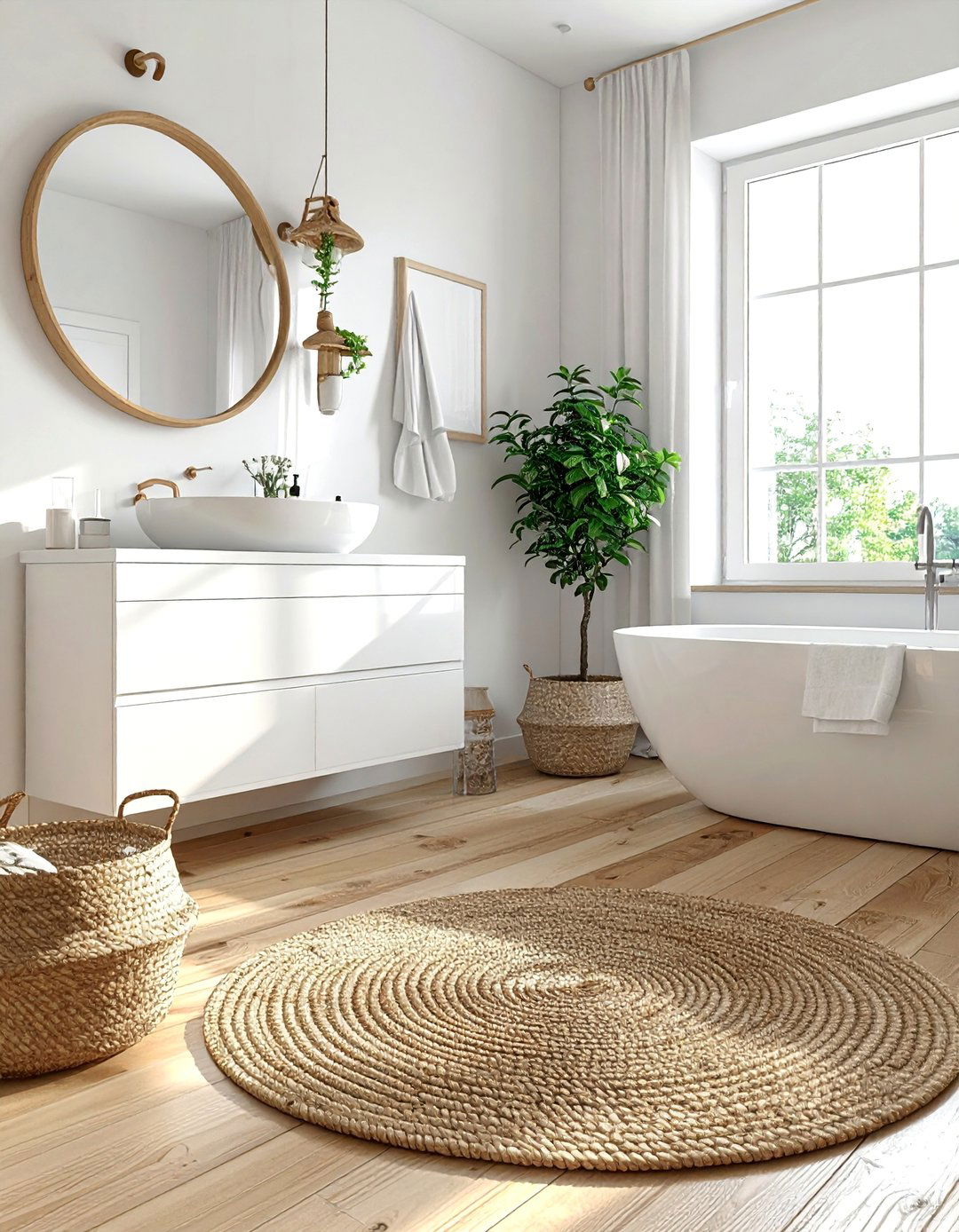
A natural fiber rug adds a layer of warmth, texture, and comfort to a Japandi bathroom. Choose a rug made from materials like jute, sisal, or seagrass to introduce an organic, earthy element that complements the wood and stone features. These materials are durable and provide a pleasant tactile sensation underfoot. Opt for a simple design, perhaps with a subtle pattern or a plain weave, to maintain the minimalist aesthetic. A round jute rug can soften the clean lines of the room, while a rectangular runner can add a sense of length. This small addition makes the space feel more inviting and complete.
17. Japandi Bathroom with Hidden Storage Solutions
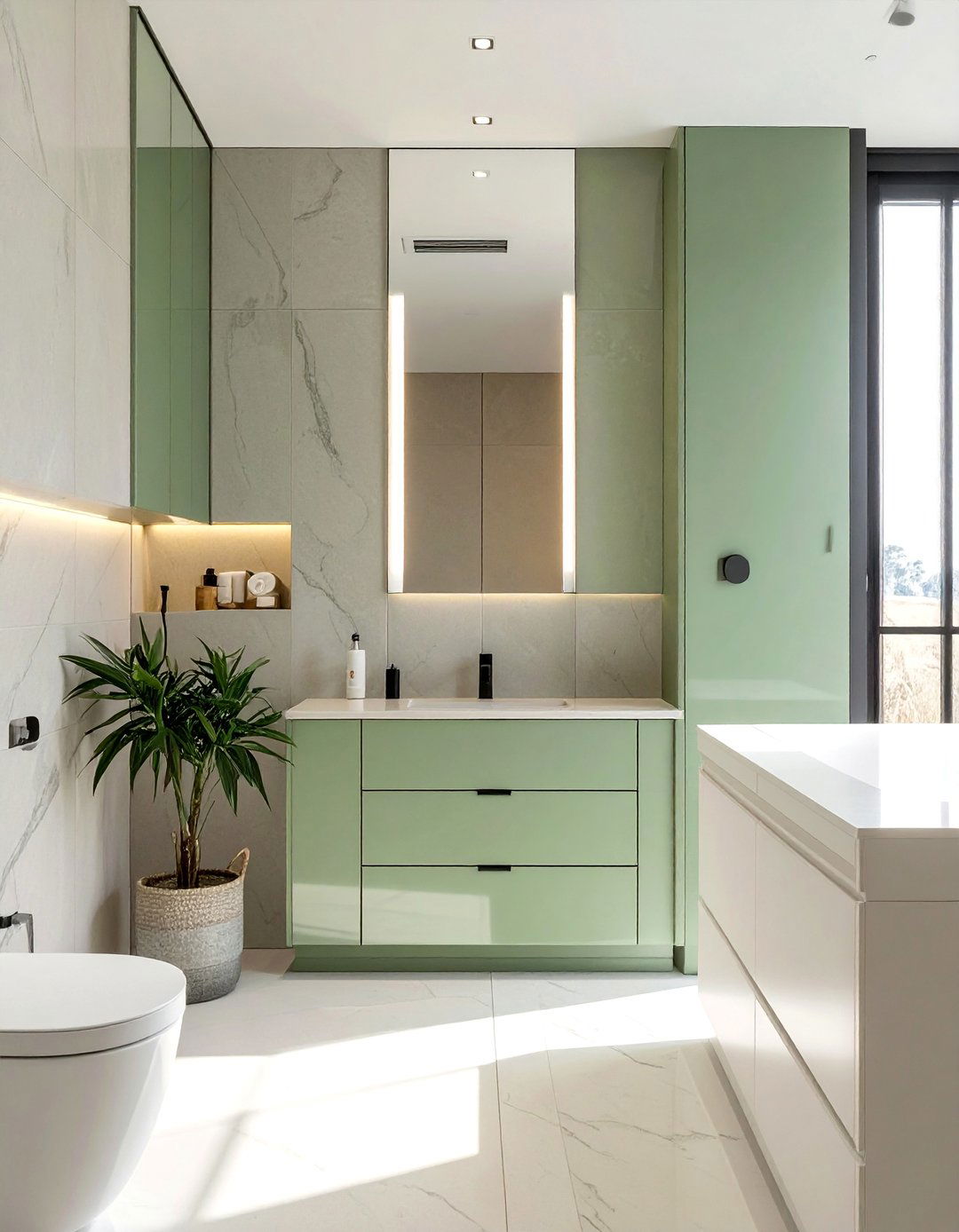
Maintaining an uncluttered aesthetic in a Japandi bathroom relies heavily on clever, hidden storage solutions. Opt for a mirrored medicine cabinet recessed into the wall to keep toiletries out of sight. A vanity with deep, handle-less drawers or integrated push-to-open mechanisms helps store larger items seamlessly. Consider built-in wall niches in the shower or above the toilet for a streamlined look. By keeping everyday necessities hidden but easily accessible, you preserve the serene and minimalist atmosphere of the space. This focus on functional, integrated storage is a hallmark of both Scandinavian efficiency and Japanese appreciation for order and tranquility.
18. Japandi Bathroom with Paper Lantern-Style Pendants
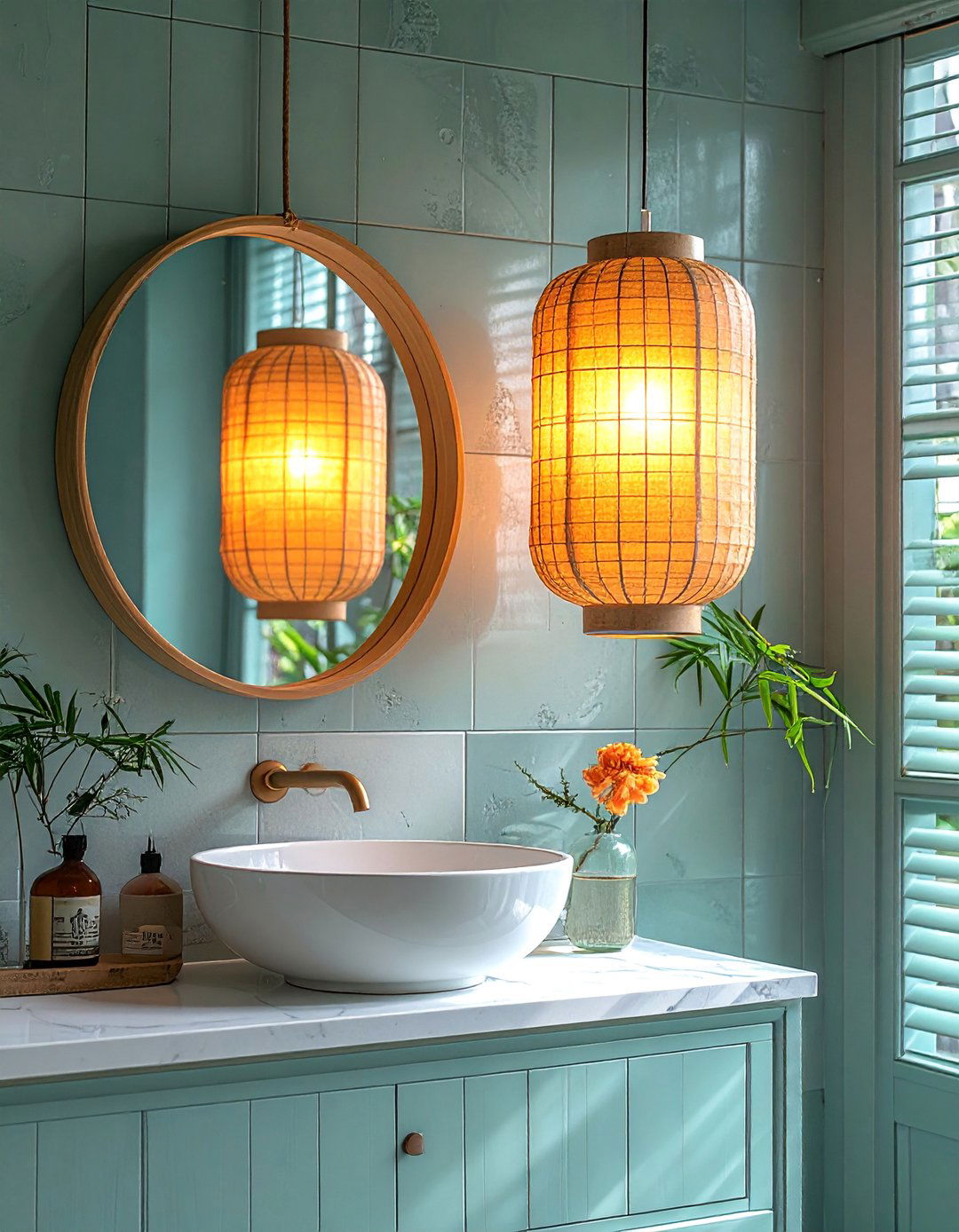
For soft, ambient lighting, incorporate a paper lantern-style pendant light into your Japandi bathroom. Inspired by traditional Japanese akari lamps, these fixtures diffuse light beautifully, casting a warm and gentle glow that enhances the room's serene atmosphere. Choose a pendant with a simple, sculptural shape made from rice paper or linen fabric. Suspend a single lantern over a corner or a pair on either side of the mirror to create a balanced and artistic focal point. This lighting choice adds a touch of organic texture and wabi-sabi elegance, moving away from purely functional fixtures to something that is both beautiful and calming.
19. Japandi Bathroom with a Pebble Tile Shower Floor
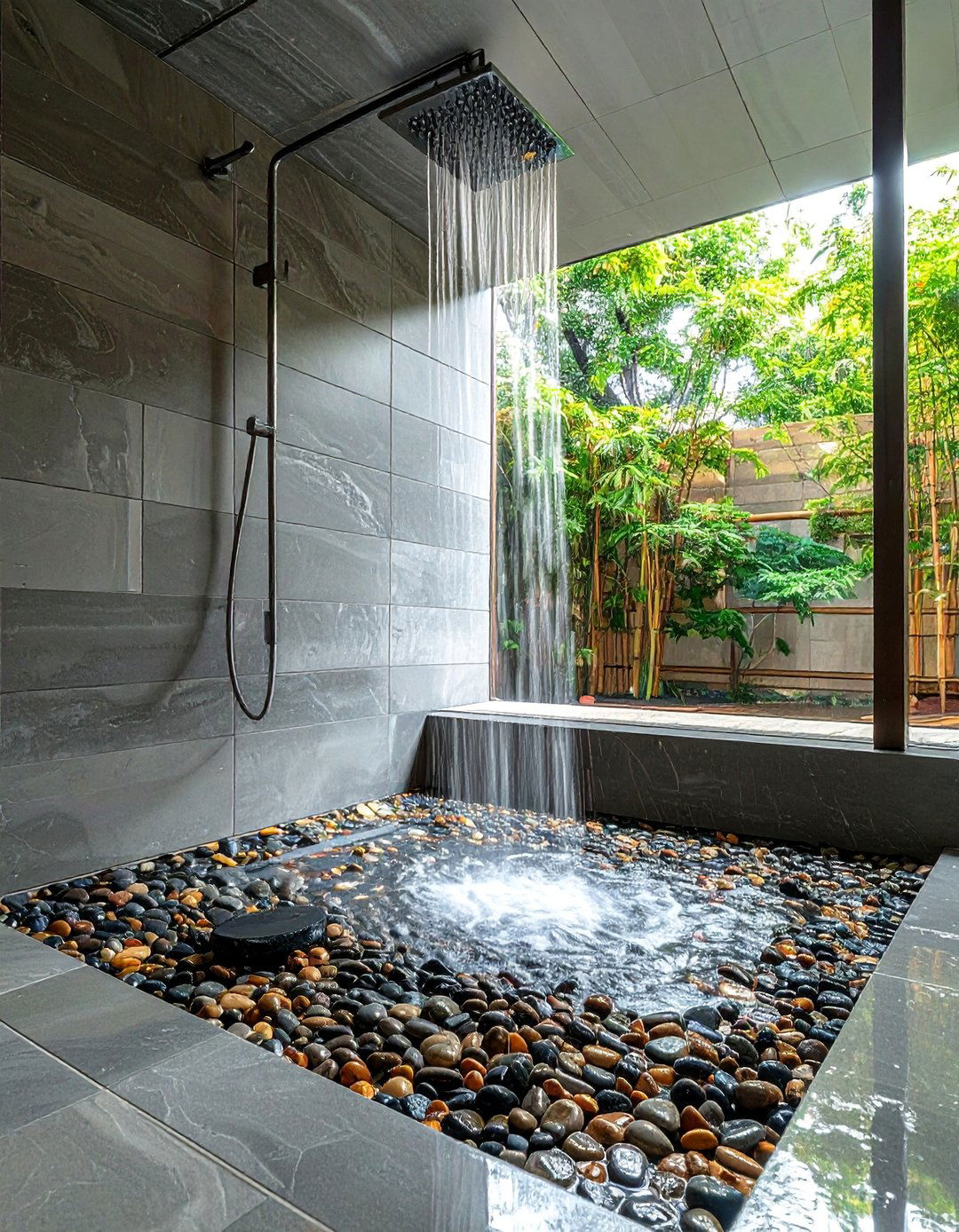
Create a spa-like, sensory experience by installing a pebble tile floor in your shower. These tiles consist of smooth, rounded river stones set in a mesh backing, bringing a direct connection to nature into your daily routine. The varied colors and shapes of the pebbles add a rich, organic texture that feels wonderful underfoot, providing a gentle massage. This design element aligns perfectly with the Japanese tradition of integrating natural elements into the home. It introduces a wabi-sabi touch, celebrating the beauty of imperfection and natural materials, while transforming your shower into a tranquil, restorative escape from the everyday.
20. Japandi Bathroom with Microcement Walls and Floor
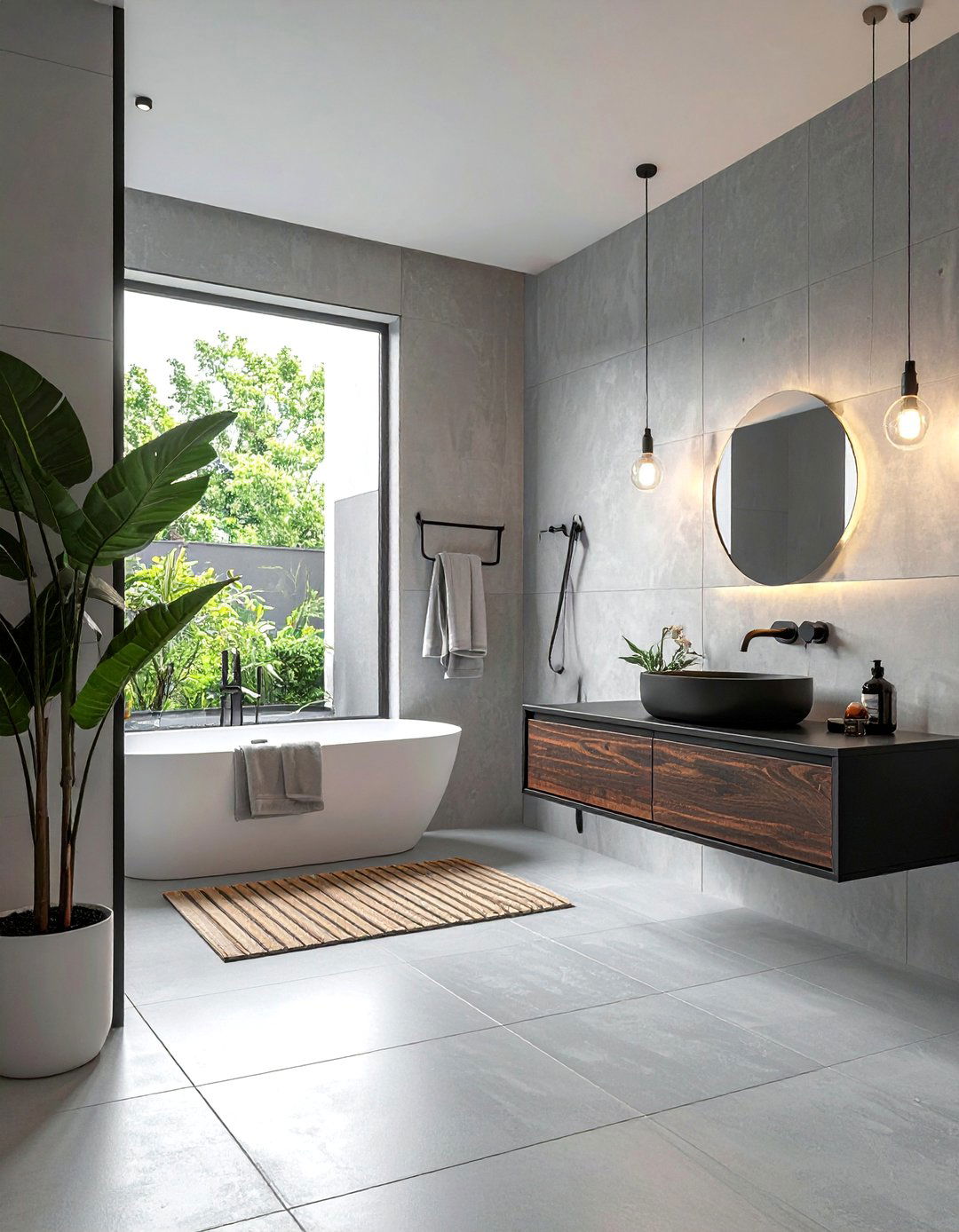
For a truly seamless and minimalist look, use microcement on both the walls and floor of your Japandi bathroom. This decorative coating is applied by hand, resulting in a continuous, grout-free surface with subtle variations in tone and texture. Its waterproof and durable nature makes it an excellent choice for wet areas, including the shower. The smooth, tactile finish creates a serene and unified space, embodying the wabi-sabi appreciation for imperfect, handcrafted beauty. Microcement provides a neutral, earthy backdrop that allows other elements, like a wooden vanity or black fixtures, to stand out, resulting in a sophisticated and deeply calming environment.
21. Japandi Bathroom with a Natural Stone Basin
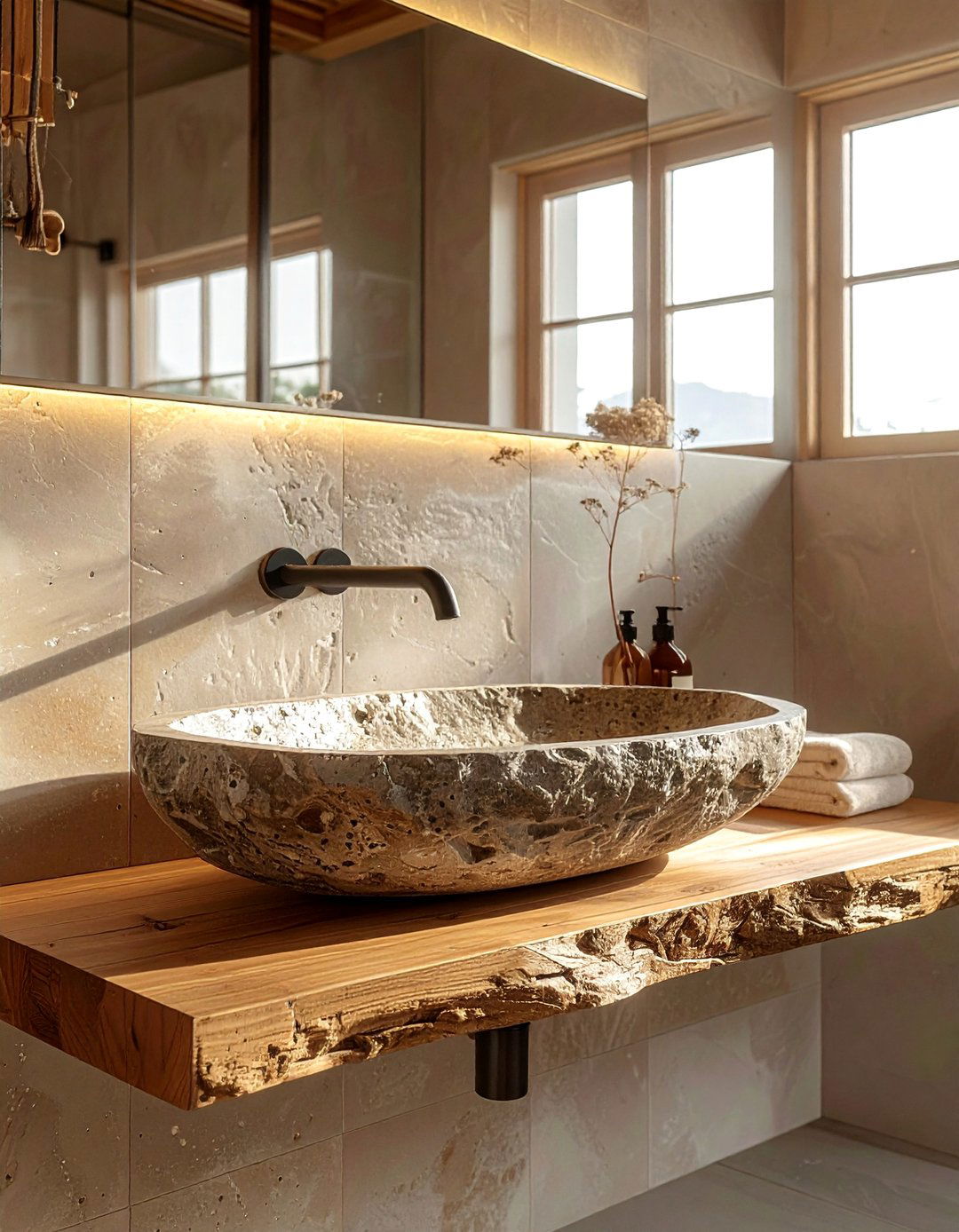
A natural stone basin is a powerful statement piece in a Japandi bathroom, connecting the space directly to the earth. Choose a vessel sink carved from materials like river stone, marble, or granite. Each basin is unique, with its own distinct veining, color, and texture, celebrating the Japanese ideal of wabi-sabi. The organic, often asymmetrical shape of a stone sink provides a beautiful contrast to the clean, straight lines of a minimalist vanity. This single element adds a touch of rustic luxury and timeless elegance, serving as a functional sculpture that elevates the simple act of washing hands into a mindful moment.
22. Japandi Bathroom with a Wall-Mounted Toilet
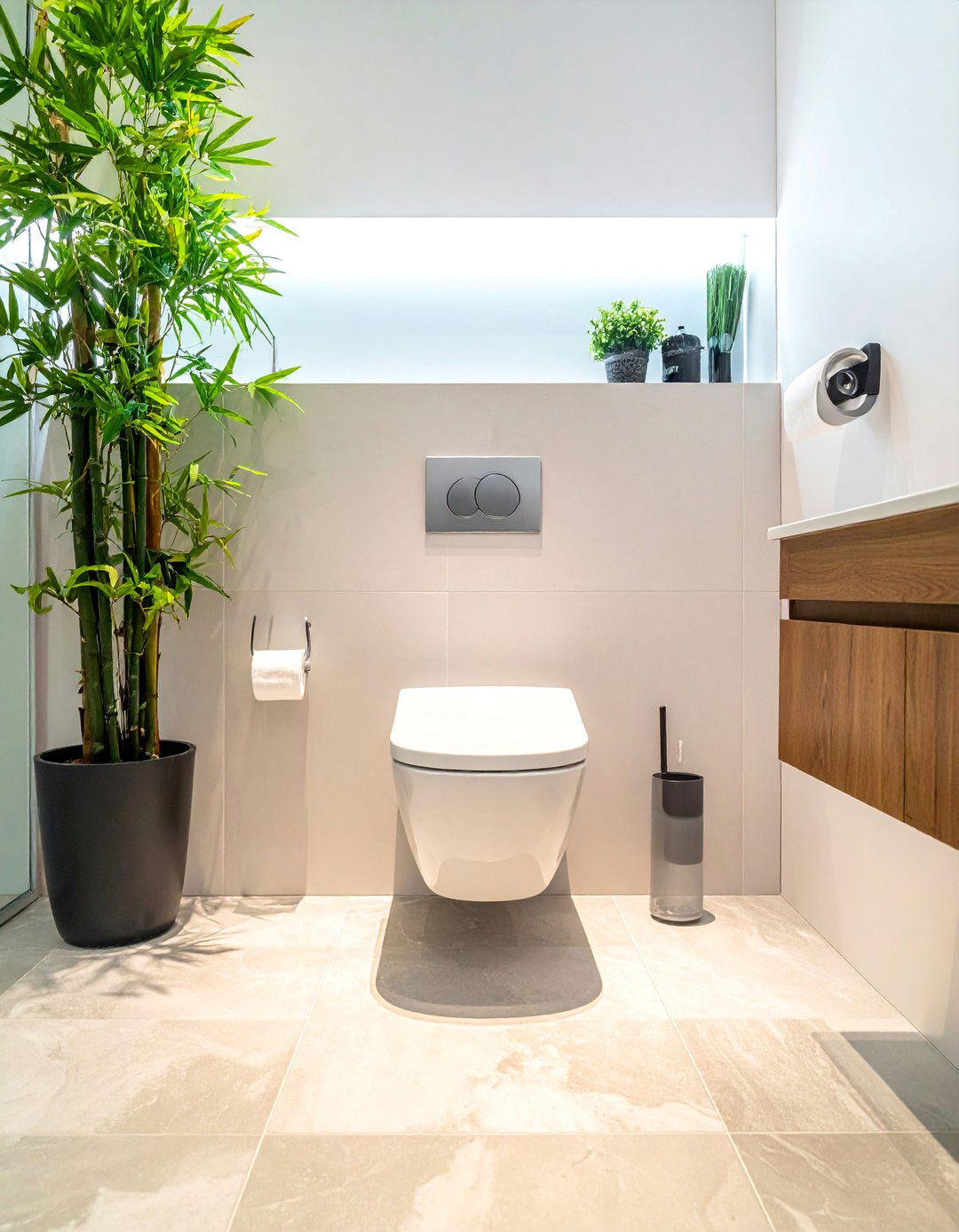
To maximize floor space and maintain a clean, uncluttered aesthetic, a wall-mounted toilet is an ideal choice for a Japandi bathroom. With the tank and plumbing concealed within the wall, only the bowl is visible, creating a sleek, minimalist profile that appears to float above the floor. This design not only enhances the sense of spaciousness but also makes cleaning the floor underneath much easier. The minimalist look aligns perfectly with both Scandinavian functionalism and Japanese simplicity. Paired with a simple, ergonomic flush plate, a wall-mounted toilet contributes to a streamlined and highly functional bathroom environment.
23. Japandi Bathroom with a Minimalist Towel Ladder
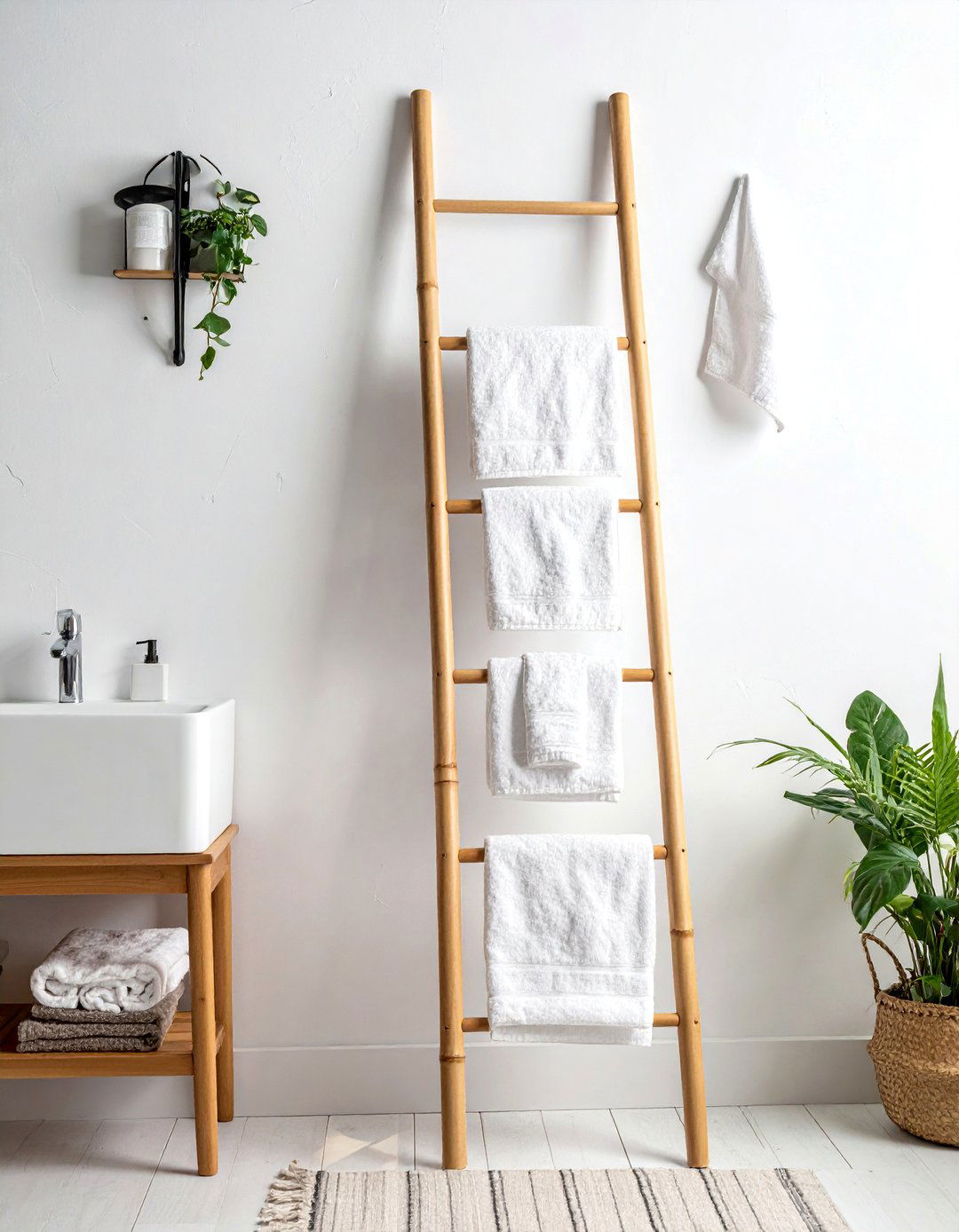
A minimalist towel ladder offers a stylish and practical alternative to traditional towel bars in a Japandi bathroom. Typically crafted from bamboo or a light-toned wood like oak, this simple piece leans against the wall, providing multiple rungs for hanging towels to dry. Its vertical design saves space and adds a subtle architectural element to the room. The ladder's clean lines and natural material perfectly capture the blend of Scandinavian functionality and Japanese aesthetics. It serves as both a functional object and a decorative accent, allowing you to display beautiful linen towels while keeping the space organized and uncluttered.
24. Japandi Bathroom with Water-Resistant Wood Wall Paneling
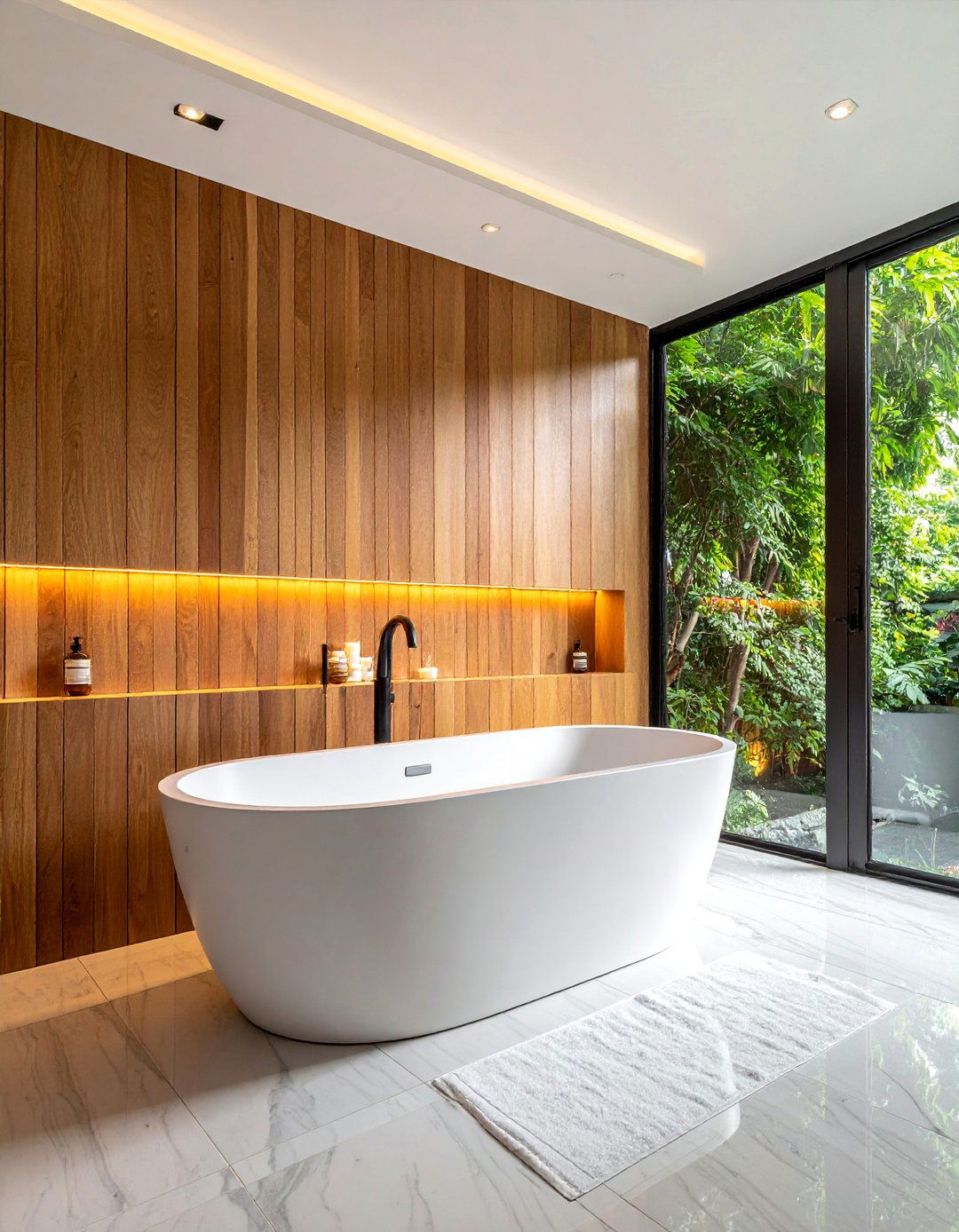
Introduce warmth and texture into your Japandi bathroom with water-resistant wood wall paneling. Use materials like teak, cedar, or thermally modified wood to create a stunning accent wall, perhaps behind the vanity or in the shower area. Vertical slats can create an illusion of height, while horizontal panels can make the space feel wider. The natural grain and rich color of the wood add a deep, organic quality that contrasts beautifully with a neutral color palette and smooth surfaces like concrete or ceramic. This feature brings the calming influence of a forest indoors, creating a cozy and spa-like atmosphere that is both inviting and sophisticated.
25. Japandi Bathroom with Woven Storage Baskets
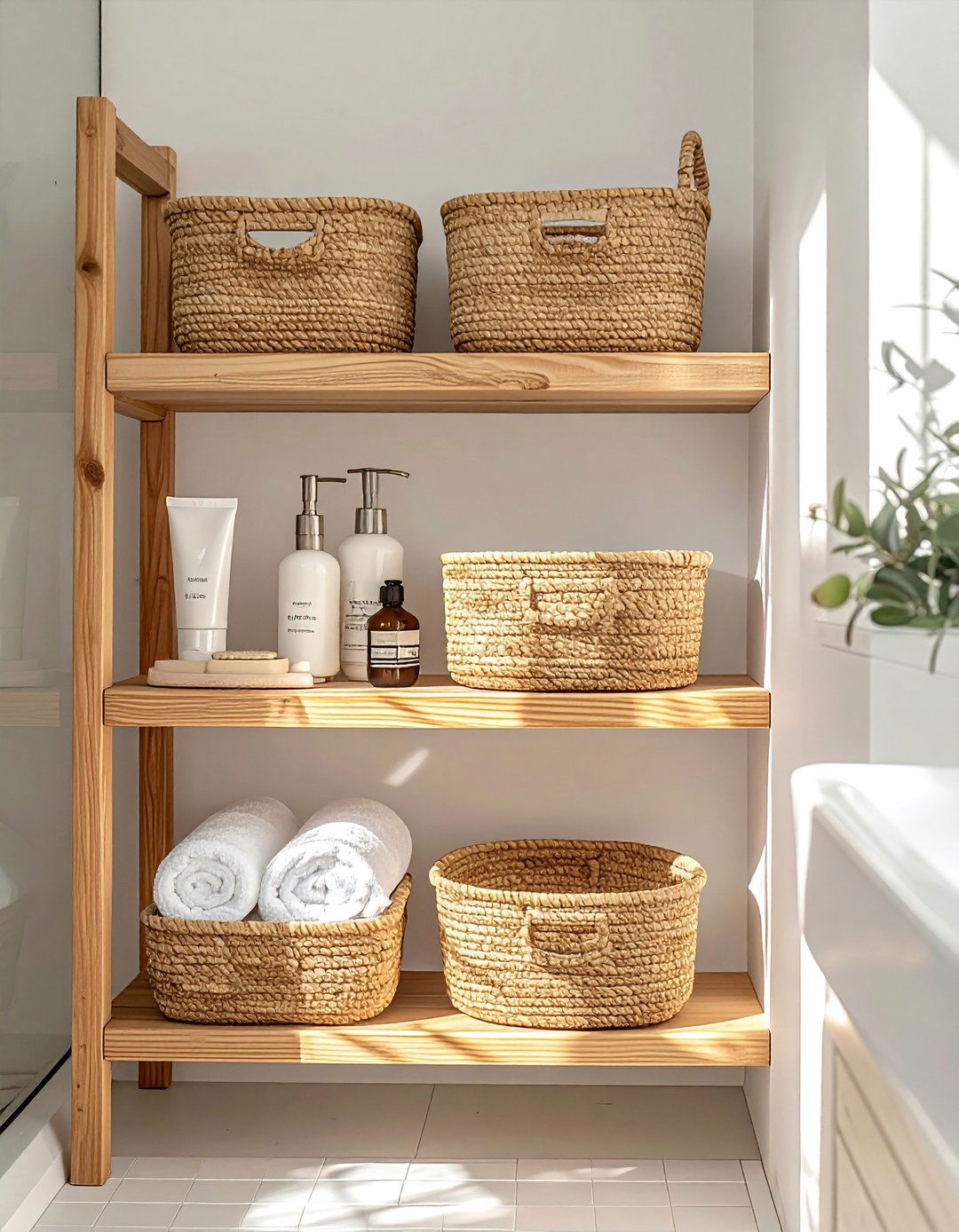
For stylish and practical organization, incorporate woven storage baskets into your Japandi bathroom. Baskets made from natural fibers like seagrass, water hyacinth, or rattan add a layer of soft, organic texture that complements the harder surfaces of tile and wood. Use them to store rolled towels on a shelf, hold toiletries on the vanity, or as a hamper for laundry. Their handcrafted quality aligns with the wabi-sabi appreciation for artisanal objects. These simple, functional accessories help keep clutter at bay while enhancing the room's warm and inviting aesthetic, blending Japanese simplicity with Scandinavian coziness and order.
26. Japandi Bathroom with Clay Plaster Wall Finish
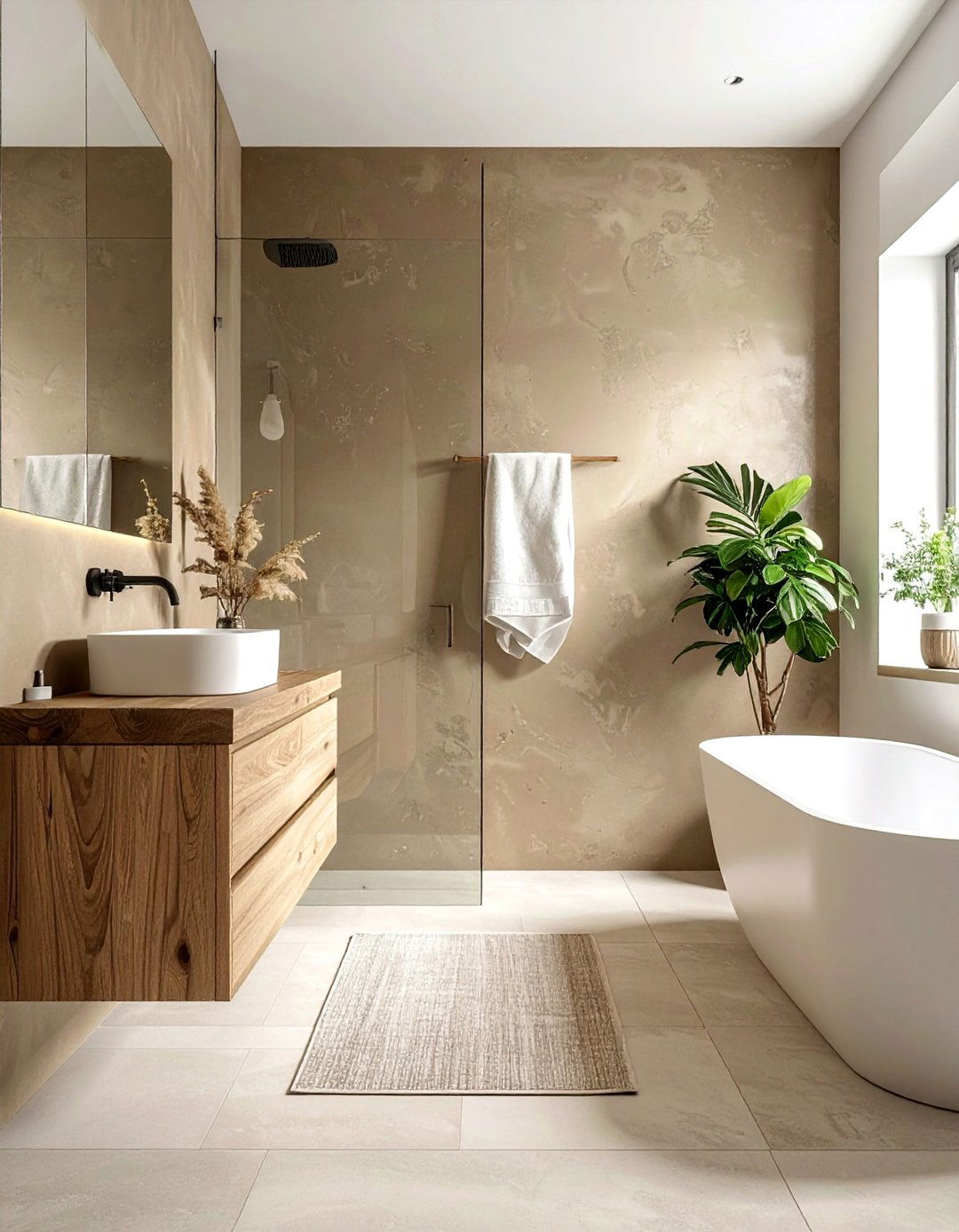
Embrace a truly organic aesthetic with a clay plaster wall finish in your Japandi bathroom. This natural, breathable material provides a soft, matte texture with subtle tonal variations that add depth and character to the space. Unlike paint, clay plaster has a unique ability to regulate humidity, making it a practical choice for a bathroom environment. The earthy, tactile quality of the finish creates a serene and grounding atmosphere, connecting the interior to the natural world. Its imperfect, handcrafted appearance is a perfect expression of wabi-sabi, providing a beautiful, calming backdrop that enhances the overall sense of tranquility and minimalist elegance.
27. Japandi Bathroom with Simple Brushed Brass Taps
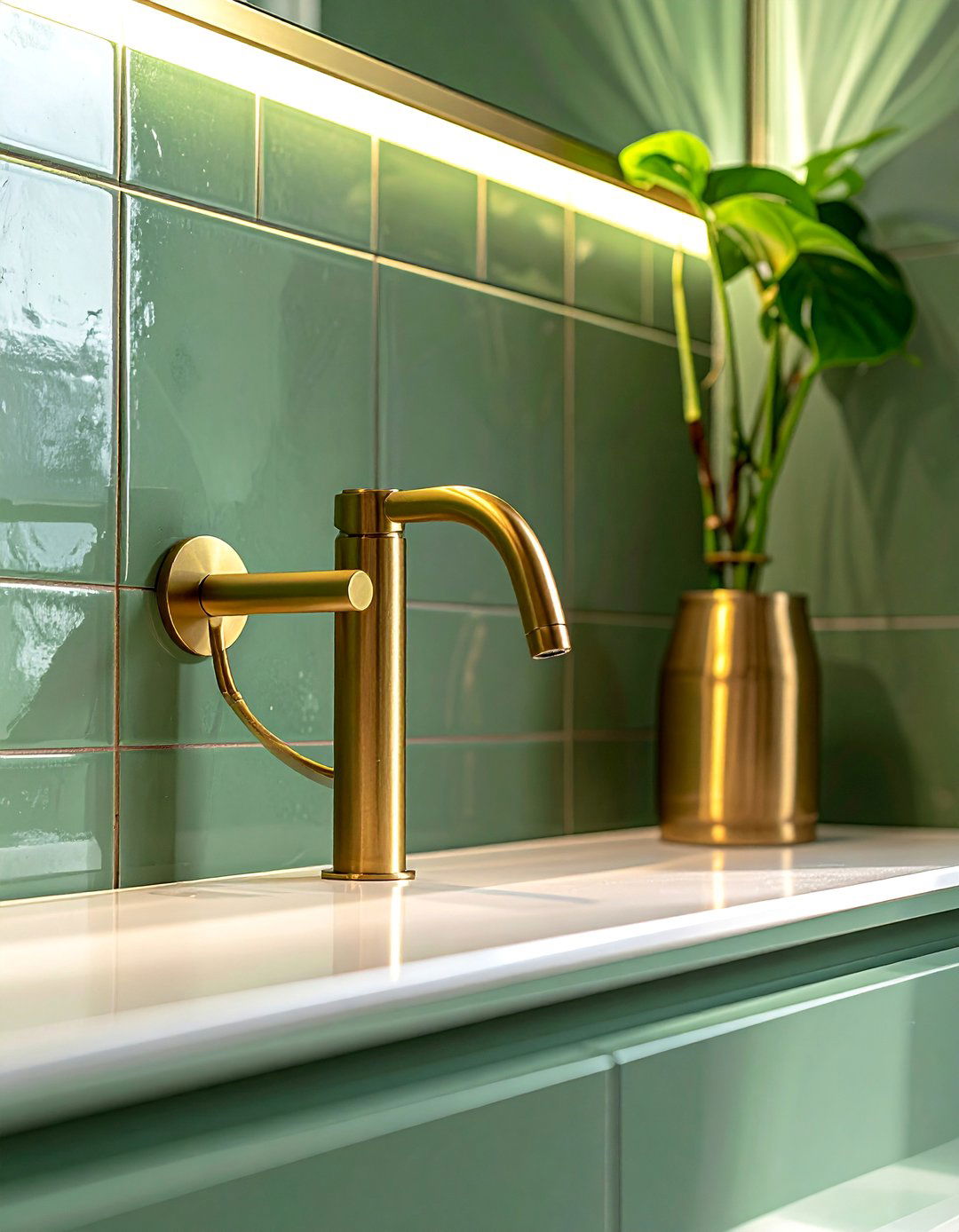
While matte black is a popular choice, simple brushed brass taps can introduce a touch of understated warmth and elegance to a Japandi bathroom. The soft, muted glow of brushed brass provides a gentle contrast against neutral tiles and dark wood, avoiding the high shine of polished finishes. This choice adds a hint of Scandinavian 'hygge' or coziness, elevating the space without being overly ornate. The clean lines of minimalist tapware ensure the look remains modern and uncluttered. This subtle metallic accent brings a sophisticated touch, beautifully complementing the natural materials and enhancing the overall serene and welcoming feel of the room.
28. Japandi Bathroom with Asymmetrical Design Layout
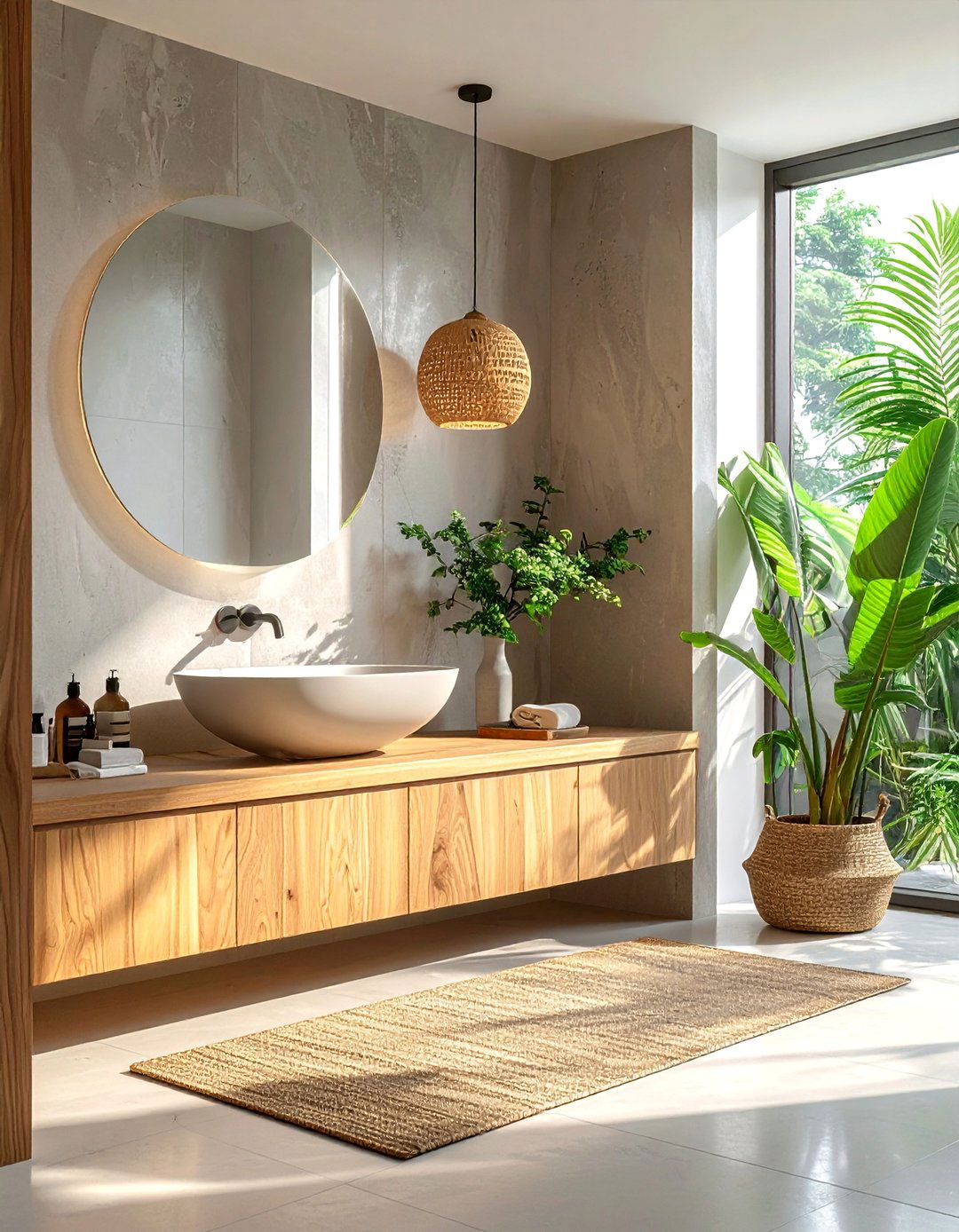
Incorporate the Japanese principle of 'fukinsei' (asymmetry) into your Japandi bathroom layout for a more dynamic and natural feel. Instead of a perfectly centered vanity and mirror, consider an offset arrangement. Place the sink to one side of the vanity, leaving a clear stretch of countertop space. Hang a mirror that is not perfectly aligned with the sink, or arrange floating shelves in a staggered pattern. This approach creates a sense of movement and visual interest that feels more organic and less rigid than a symmetrical layout. It reflects the beauty found in nature's imperfections, resulting in a balanced yet engaging design.
29. Japandi Bathroom with a Low-Profile Wooden Stool
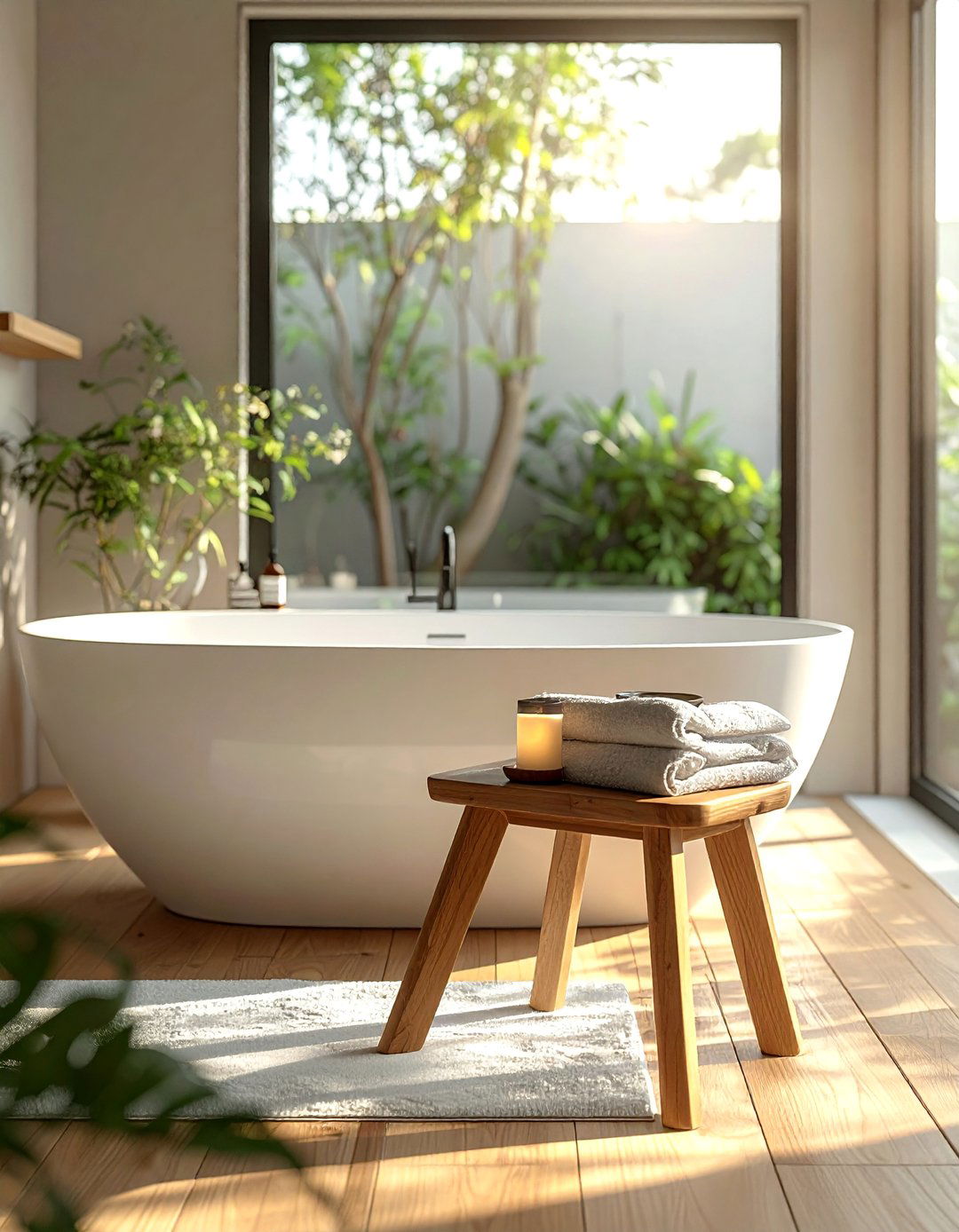
A low-profile wooden stool is a versatile and essential element in a Japandi bathroom. This simple, beautifully crafted piece can be used as a seat, a side table next to the tub for a book and a candle, or a stand for a potted plant. Choose a stool made from reclaimed or light-toned wood with clean lines and a simple construction. Its small footprint and multifunctional nature embody both Japanese simplicity and Scandinavian practicality. The addition of this single, humble object adds a touch of organic warmth and wabi-sabi charm, enhancing the room’s functionality and serene, spa-like atmosphere without adding clutter.
30. Japandi Bathroom with a Single Tranquil Art Piece
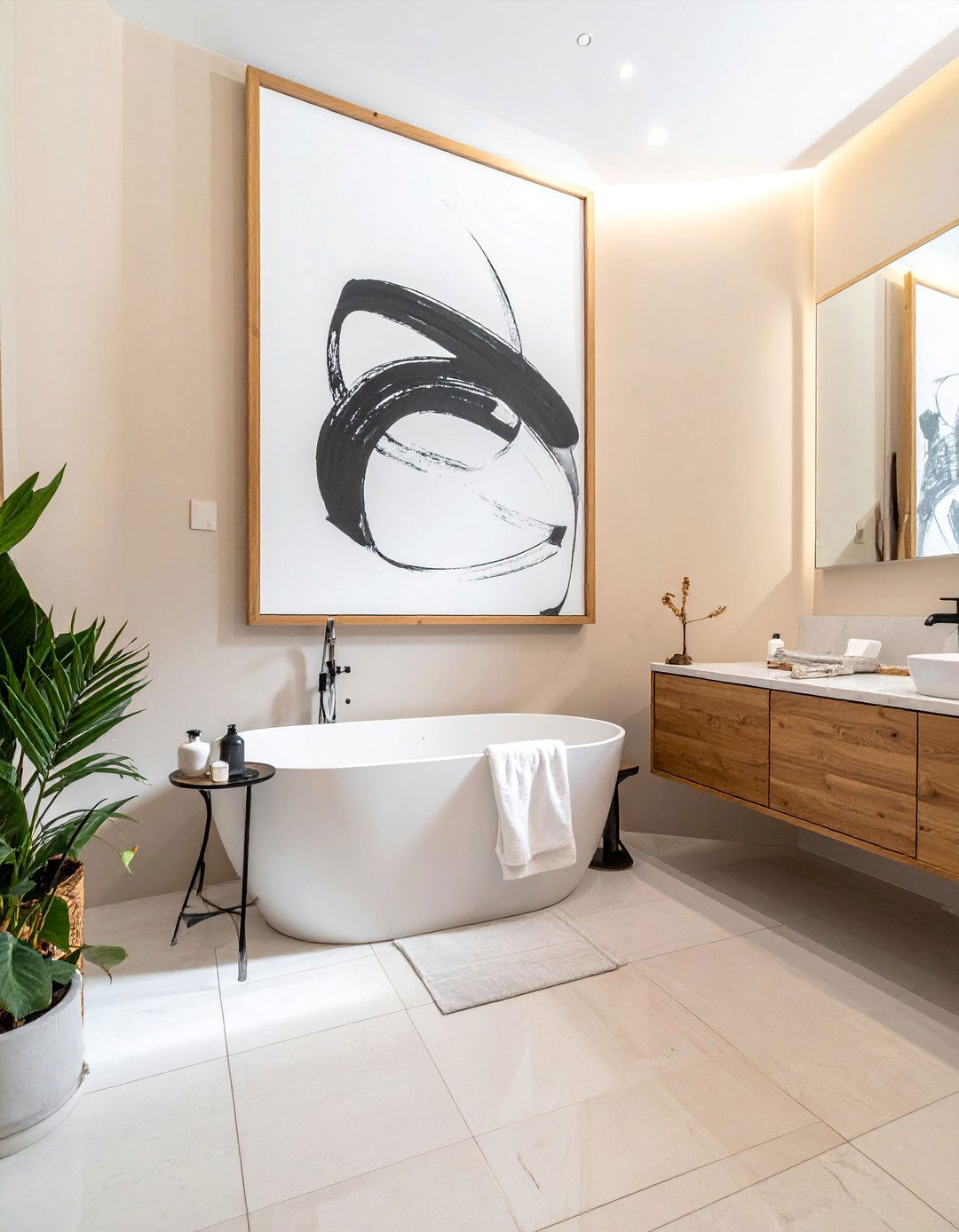
To maintain a minimalist aesthetic while adding a personal touch, adorn a wall in your Japandi bathroom with a single, tranquil art piece. Choose a work that evokes a sense of calm, such as an abstract piece with soft, flowing lines, a simple ink wash painting of a natural landscape, or a photograph of a serene scene. The key is to select something understated that complements the neutral color palette. A simple wood or black frame will maintain the minimalist feel. This one focal point adds a layer of sophistication and personality without creating visual clutter, encouraging a moment of quiet contemplation.
31. Japandi Bathroom with a Seamless Glass Shower Enclosure
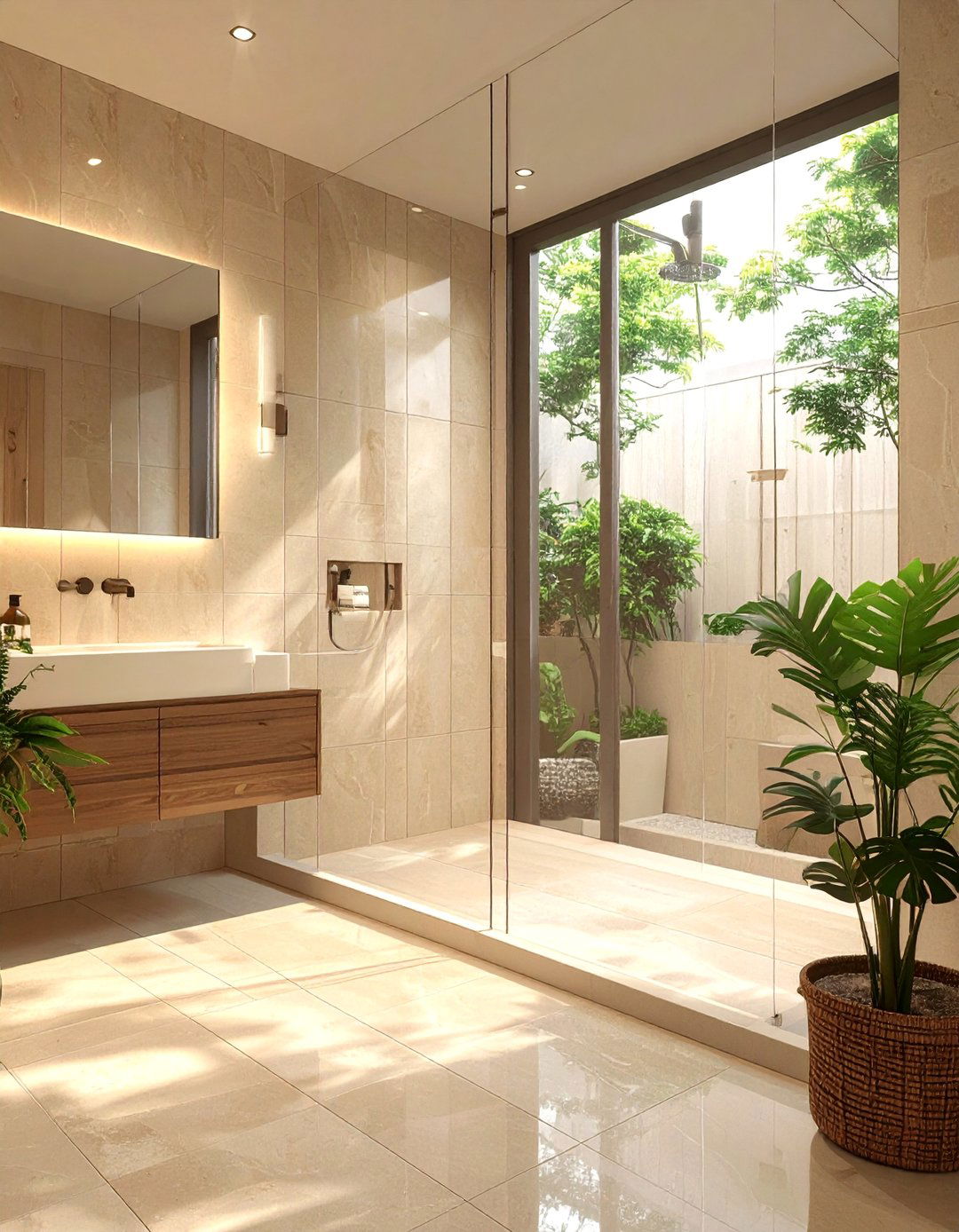
For an utterly clean and open feel, a seamless glass shower enclosure is the perfect choice for a Japandi bathroom. Using large panes of frameless or minimally framed glass creates an uninterrupted sightline, making the entire bathroom feel larger and more airy. This design choice puts the focus on the beautiful tilework or fixtures within the shower itself. The transparency enhances the flow of light throughout the space, contributing to a bright and serene atmosphere. This commitment to functional simplicity and visual lightness is a core tenet of both Scandinavian and Japanese design, resulting in a sophisticated and modern look.
32. Japandi Bathroom with a Bench Inside the Shower
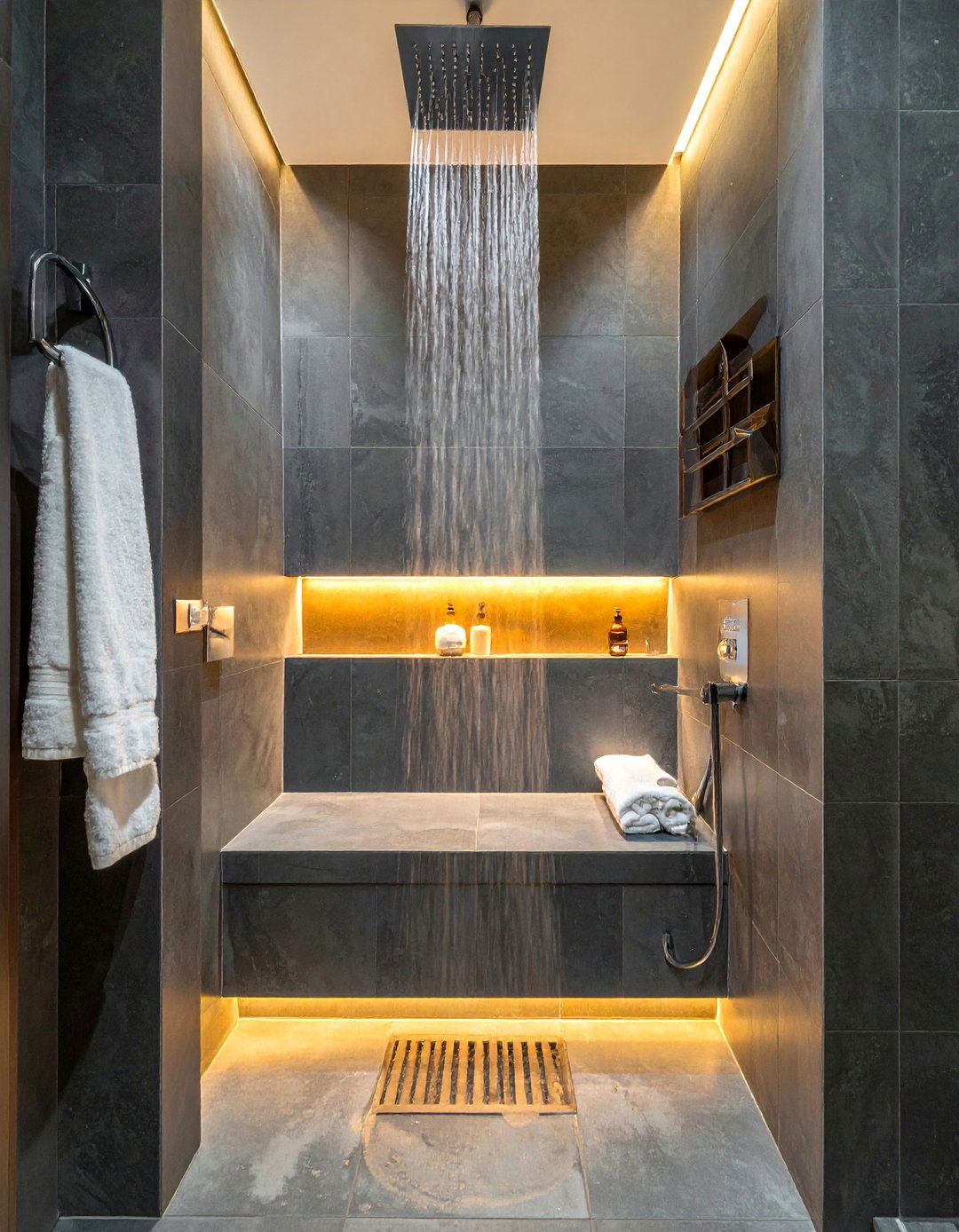
Enhance the functionality and spa-like luxury of your shower by incorporating a built-in or freestanding bench. A built-in bench, tiled to match the shower walls, creates a seamless look, while a simple teak or Hinoki wood stool adds a warm, natural element. This feature provides a comfortable spot to sit and relax under the water, turning a routine shower into a more mindful and restorative experience. It’s a practical addition for tasks like shaving, yet it primarily serves to elevate the sense of comfort and tranquility, aligning with the Japandi focus on well-being and creating a personal sanctuary within the home.
33. Japandi Bathroom with Dimmable Ambient Lighting
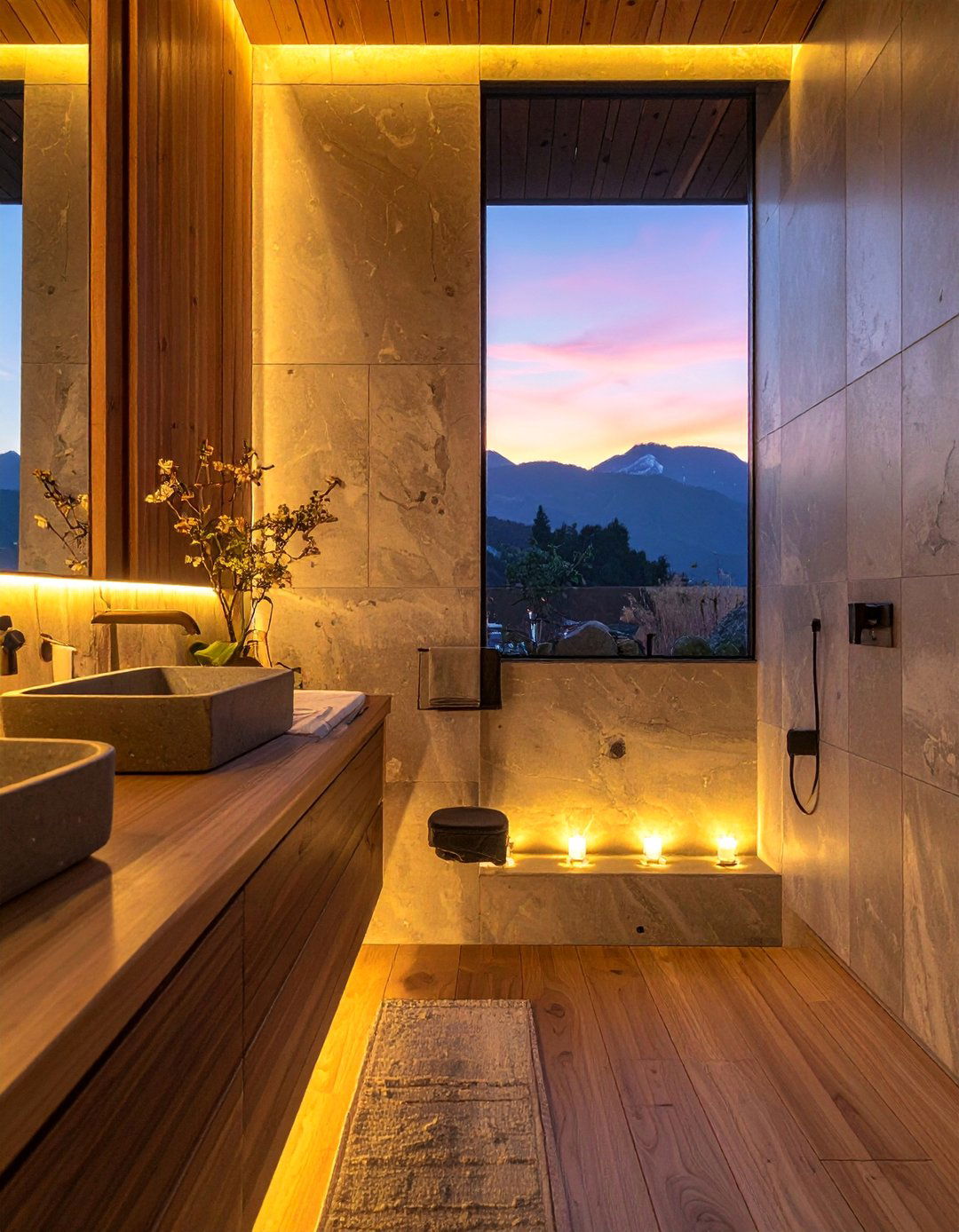
Creating the right mood in a Japandi bathroom is crucial, and dimmable ambient lighting is the key. Install dimmers on your main light sources, such as recessed ceiling lights or wall sconces, to allow for complete control over the atmosphere. Bright light is essential for functional tasks in the morning, but the ability to lower the illumination in the evening creates a soft, relaxing glow perfect for unwinding in a bath. This flexibility allows the bathroom to transition from a practical space to a serene retreat. This blend of modern functionality and atmospheric control perfectly captures the essence of Japandi design.
34. Japandi Bathroom with a Single-Handle Minimalist Faucet
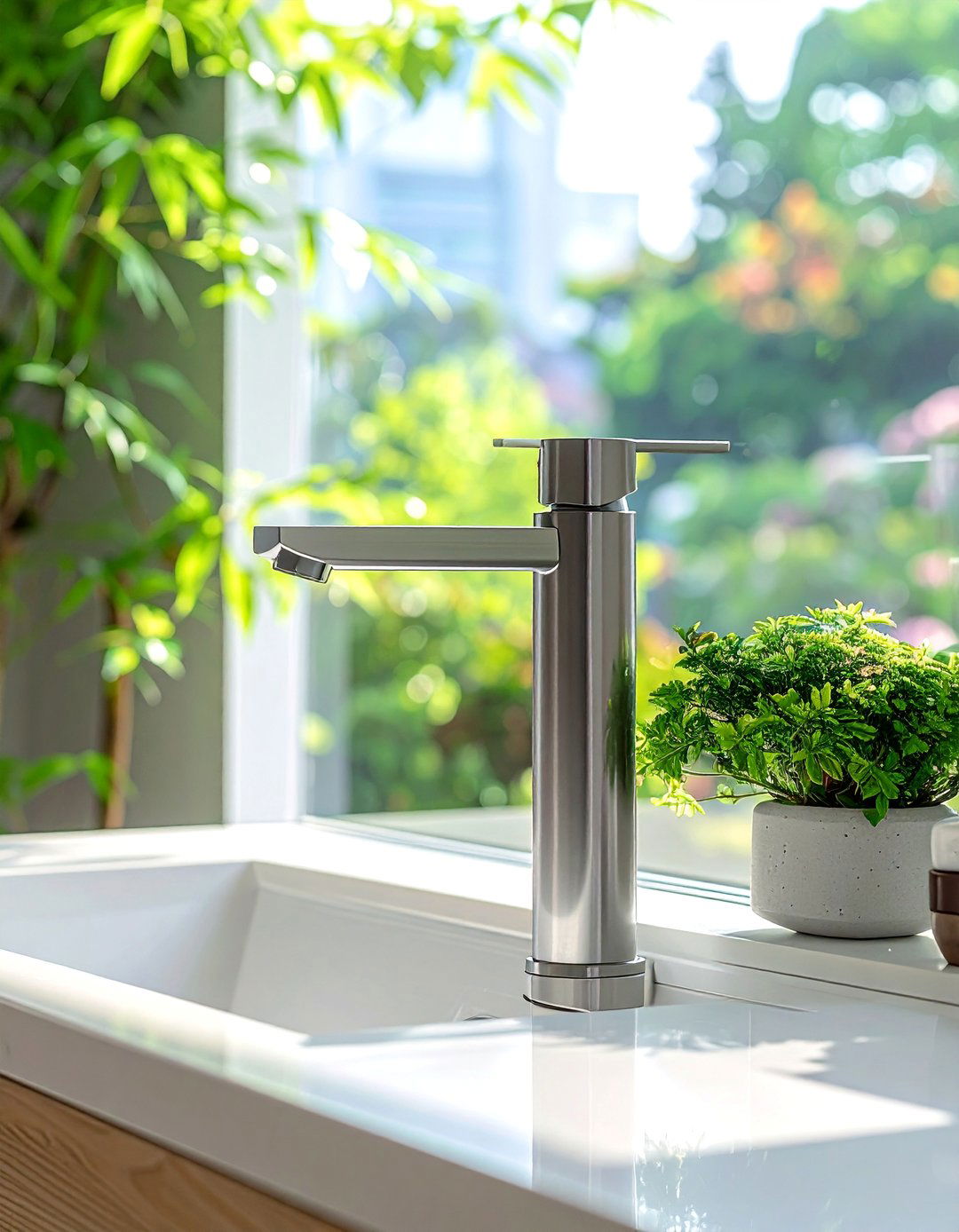
A single-handle minimalist faucet combines sleek design with effortless functionality, making it a perfect fit for a Japandi bathroom. Its streamlined form, free of unnecessary ornamentation, contributes to the room's clean and uncluttered aesthetic. The single lever for controlling both temperature and flow is intuitive and practical, embodying the Scandinavian principle of efficient design. Choose a faucet in a matte black, brushed brass, or brushed nickel finish to complement the other fixtures and materials in the space. This simple yet elegant choice enhances the modern feel of the bathroom while prioritizing ease of use and visual simplicity.
35. Japandi Bathroom with Earthy Green or Blue Tiles
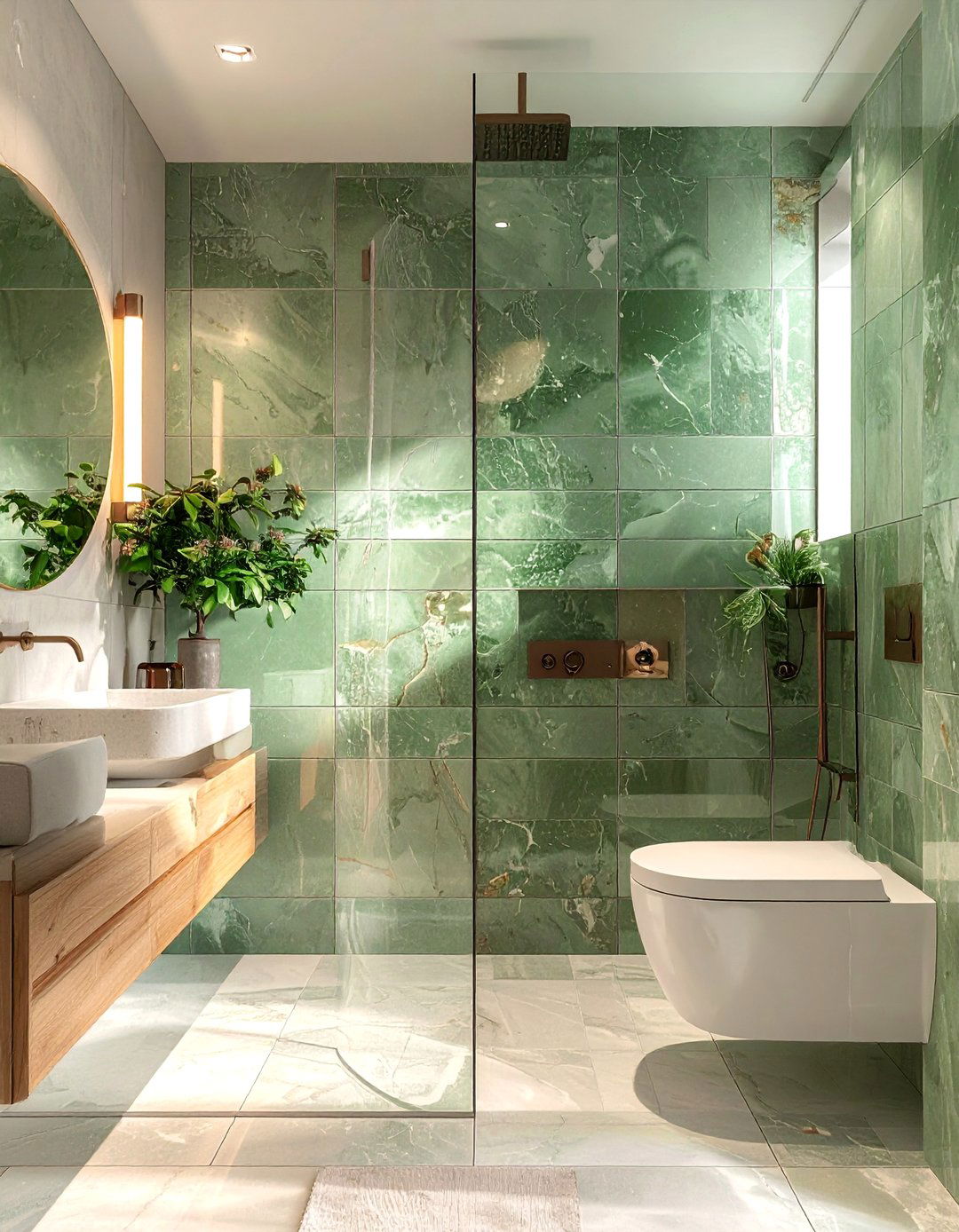
While Japandi design is known for its neutral palette, introducing a touch of subtle color with earthy green or blue tiles can create a serene, nature-inspired accent. Use these tiles for a shower wall or a backsplash behind the vanity. Opt for muted, desaturated shades like sage green, dusty blue, or deep teal to maintain a calming atmosphere. The color evokes a sense of tranquility associated with forests or water, reinforcing the connection to the natural world. A matte or zellige-style finish with slight variations in color will add texture and a wabi-sabi feel, enriching the space without overpowering its minimalist foundation.
36. Japandi Bathroom with Vertical Wood Slat Wall Details
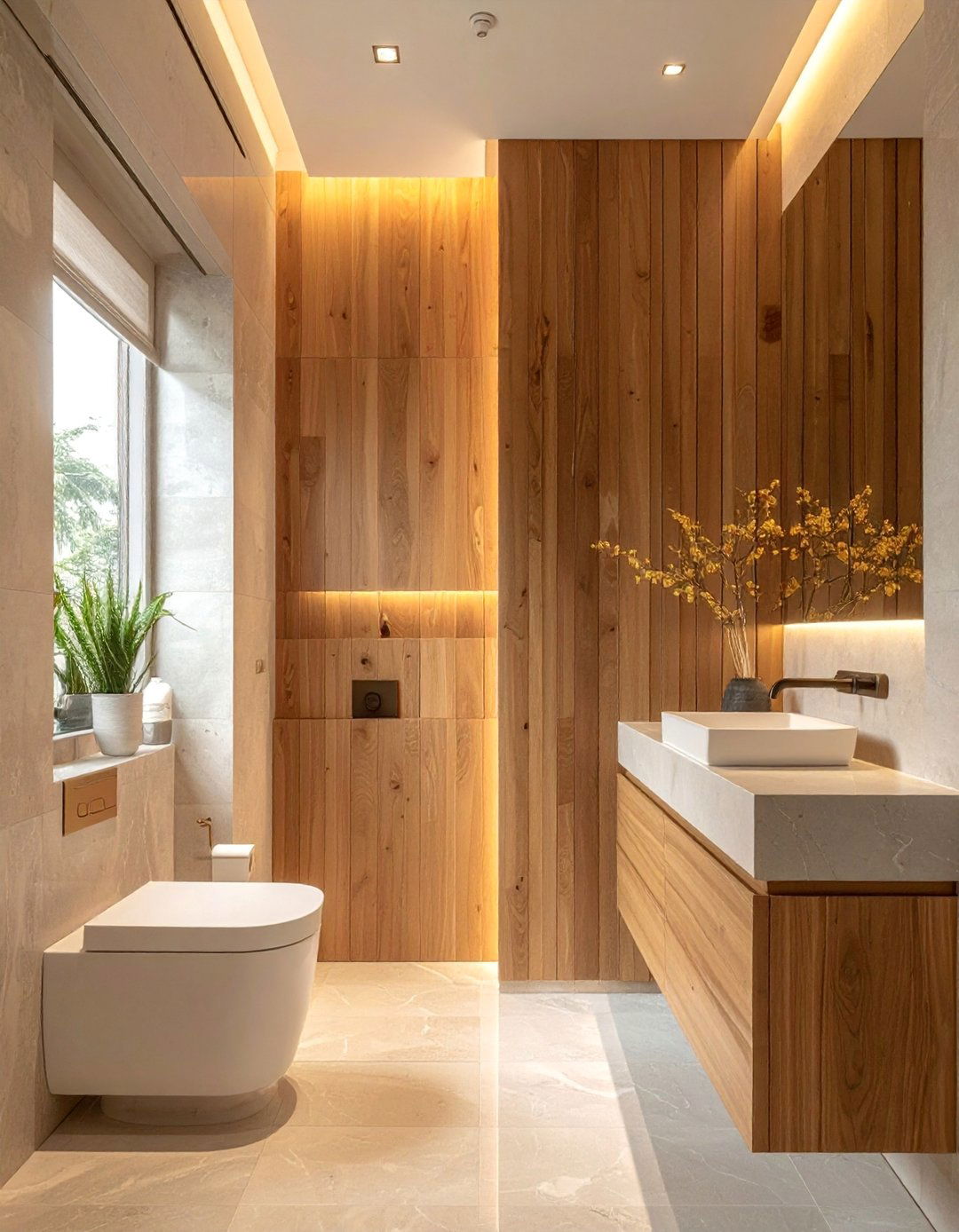
Vertical wood slats are a signature element in Japandi design, offering a way to add texture, warmth, and a sense of height to a bathroom. Install a feature wall of light oak or cedar slats behind the vanity or along one wall to create a stunning architectural detail. The clean, linear pattern brings a sense of order and rhythm to the space, while the natural wood grain introduces an organic element. This design can also cleverly conceal a door or storage cabinet for a seamless look. The interplay of light and shadow on the slatted surface adds depth and visual interest, enhancing the room’s sophisticated yet natural aesthetic.
37. Japandi Bathroom with Handmade Ceramic Accessories
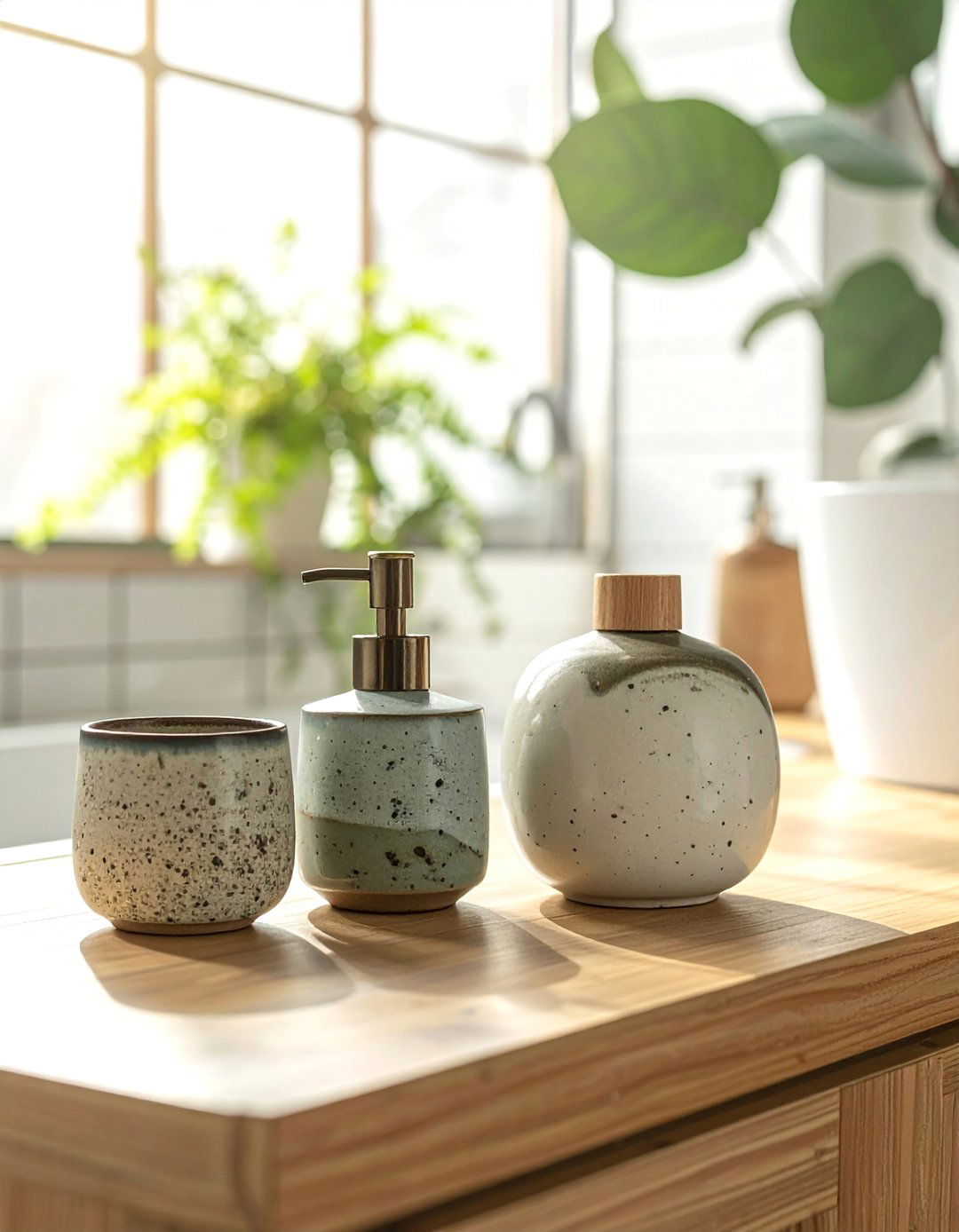
Accessorize your Japandi bathroom with a curated selection of handmade ceramic pieces. Items like a soap dish, toothbrush holder, or a small vase in earthy, neutral tones add a touch of artisanal charm. The slight imperfections and unique glazes of handcrafted ceramics celebrate the wabi-sabi philosophy of finding beauty in the imperfect. These objects are not just functional; they are small works of art that bring a sense of soul and character to the space. By choosing quality, thoughtfully made items over mass-produced ones, you honor the Japandi principles of craftsmanship, simplicity, and mindful consumption, completing the serene and personalized feel of your bathroom.
38. Japandi Bathroom with a Simple, Unframed Arch Mirror
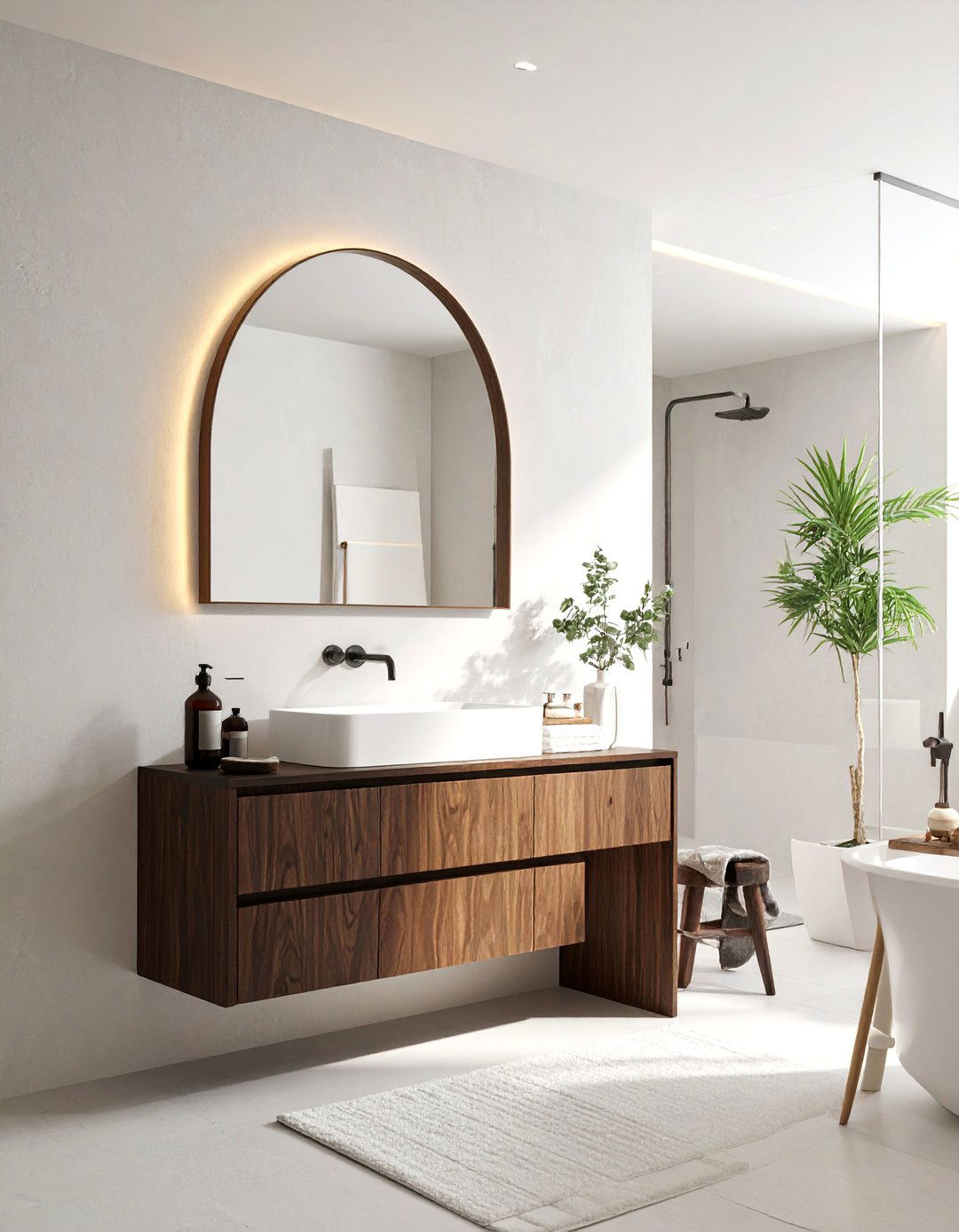
An unframed arch mirror introduces a soft, graceful curve into the typically linear Japandi bathroom. The elegant arch shape provides a gentle contrast to the straight lines of the vanity, tiles, and fixtures, adding a touch of classic sophistication without being ornate. Its simple, frameless design keeps the look minimalist and modern, allowing the shape itself to be the focal point. This choice helps to create a sense of height and openness, reflecting light and making the space feel brighter and more inviting. It’s a subtle yet impactful way to add a sculptural element that enhances the room's serene and balanced aesthetic.
39. Japandi Bathroom with Natural Linen Shower Curtains
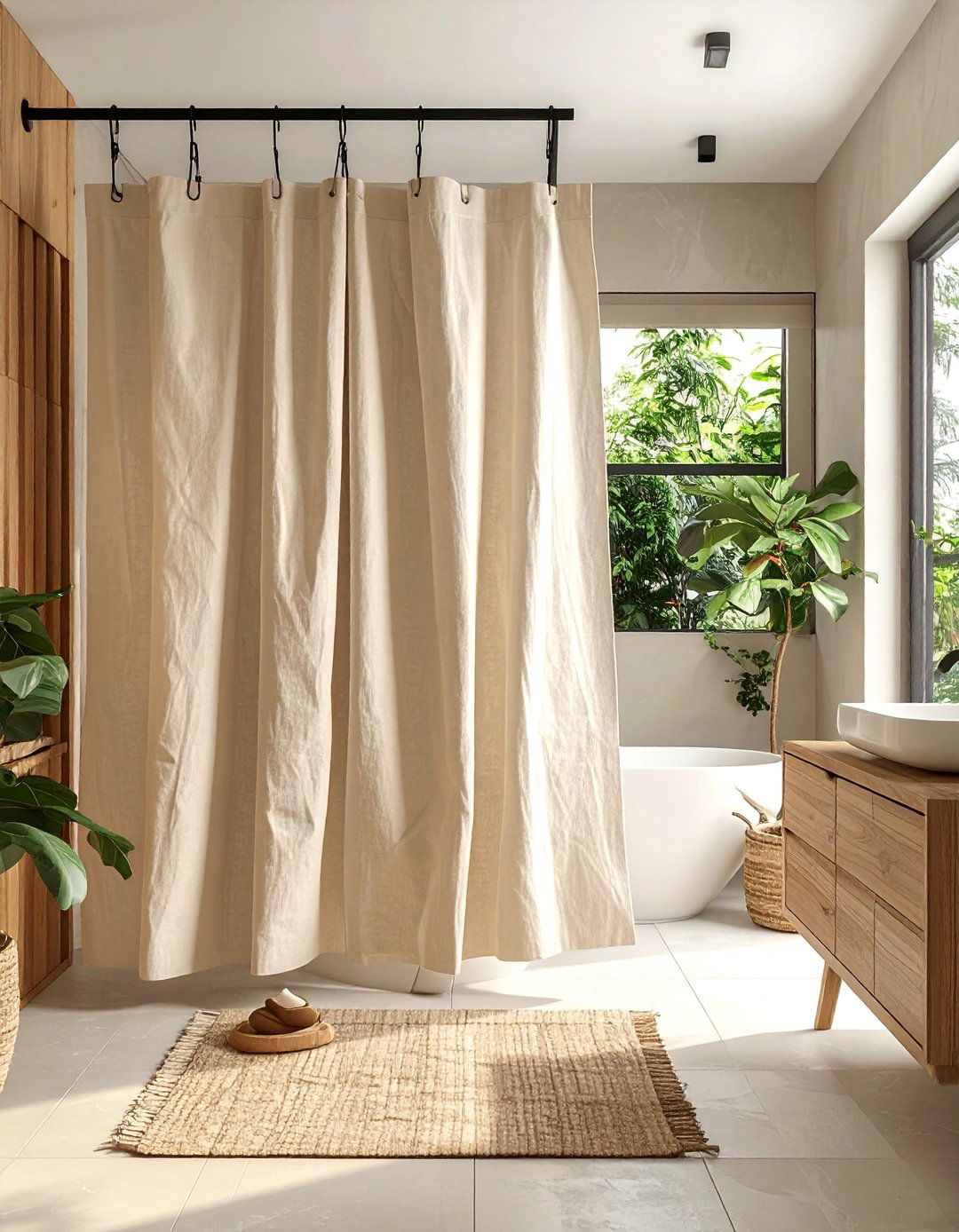
For bathrooms with a tub-shower combination, a natural linen shower curtain is the perfect Japandi choice. Unlike vinyl curtains, linen offers a soft, tactile quality and a beautiful, relaxed drape that adds a touch of understated luxury. Choose a curtain in a neutral, earthy tone like oatmeal, off-white, or soft gray to complement the rest of the color palette. The natural texture of the fabric enhances the room's organic feel and contributes to a cozy, inviting atmosphere. This simple swap elevates the look of the bathroom, replacing a purely functional item with one that is both beautiful and in harmony with the natural, minimalist aesthetic.
40. Japandi Bathroom with a Skylight for Natural Light
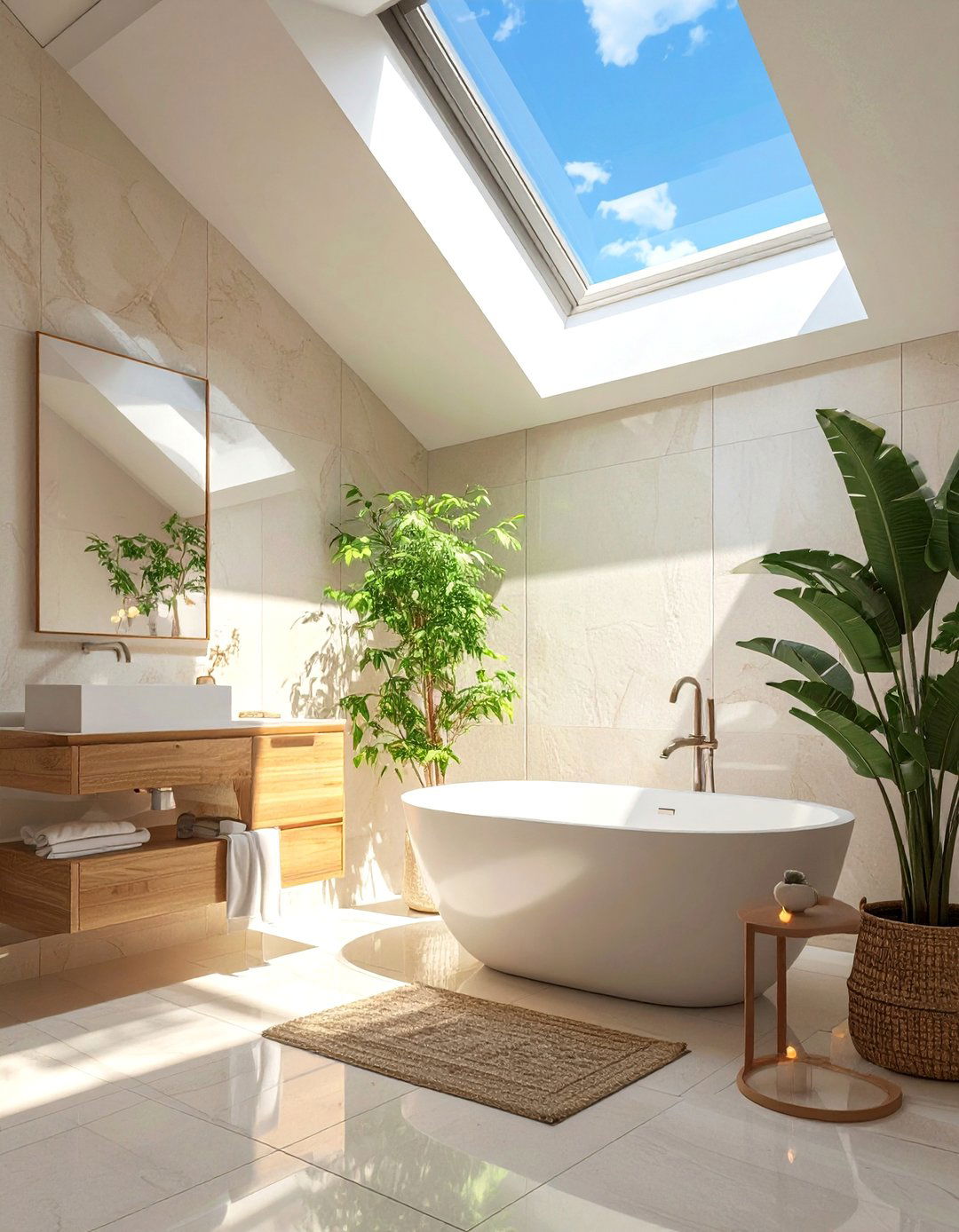
Maximizing natural light is a key principle of both Japanese and Scandinavian design, and a skylight is an excellent way to achieve this in a bathroom. By installing a skylight directly above the shower or freestanding tub, you can flood the space with soft, diffused daylight, creating a bright and airy atmosphere. This connection to the outdoors and the changing light throughout the day enhances the sense of tranquility and well-being. A skylight reduces the need for artificial lighting, contributing to a more natural and energy-efficient environment. It transforms the bathroom into a serene sanctuary, making it feel open, spacious, and deeply connected to nature.
Conclusion:
Embracing Japandi design for your bathroom means creating a sanctuary of calm, function, and natural beauty. This style masterfully blends the minimalist practicality of Scandinavian design with the serene, organic elegance of Japanese aesthetics. By focusing on clean lines, a neutral color palette, natural materials like wood and stone, and uncluttered spaces, you can achieve a harmonious balance. The core idea is to prioritize quality, craftsmanship, and mindfulness, turning a daily routine into a peaceful ritual. A Japandi bathroom is more than a trend; it is a timeless approach to creating a restorative and soulful personal space.

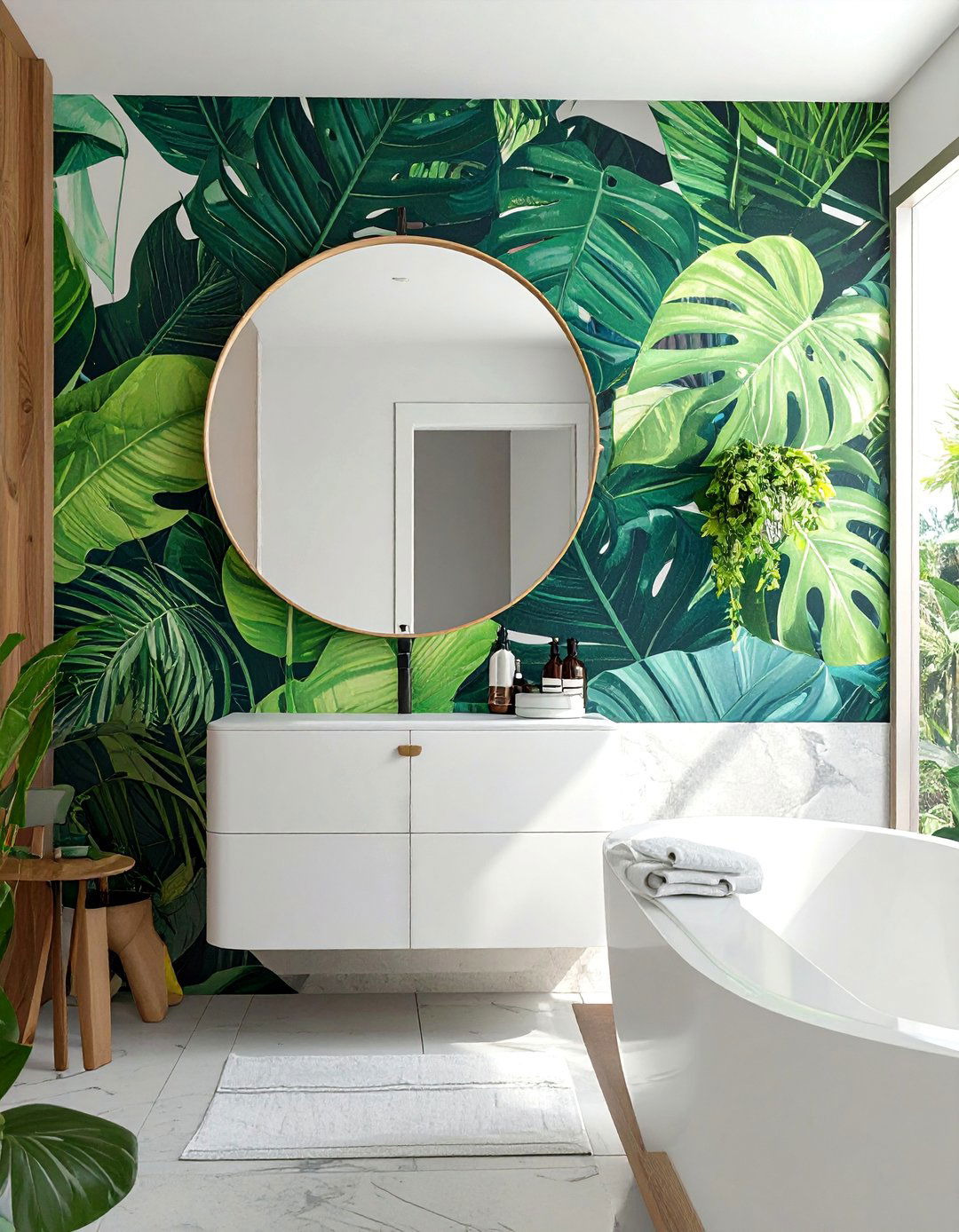
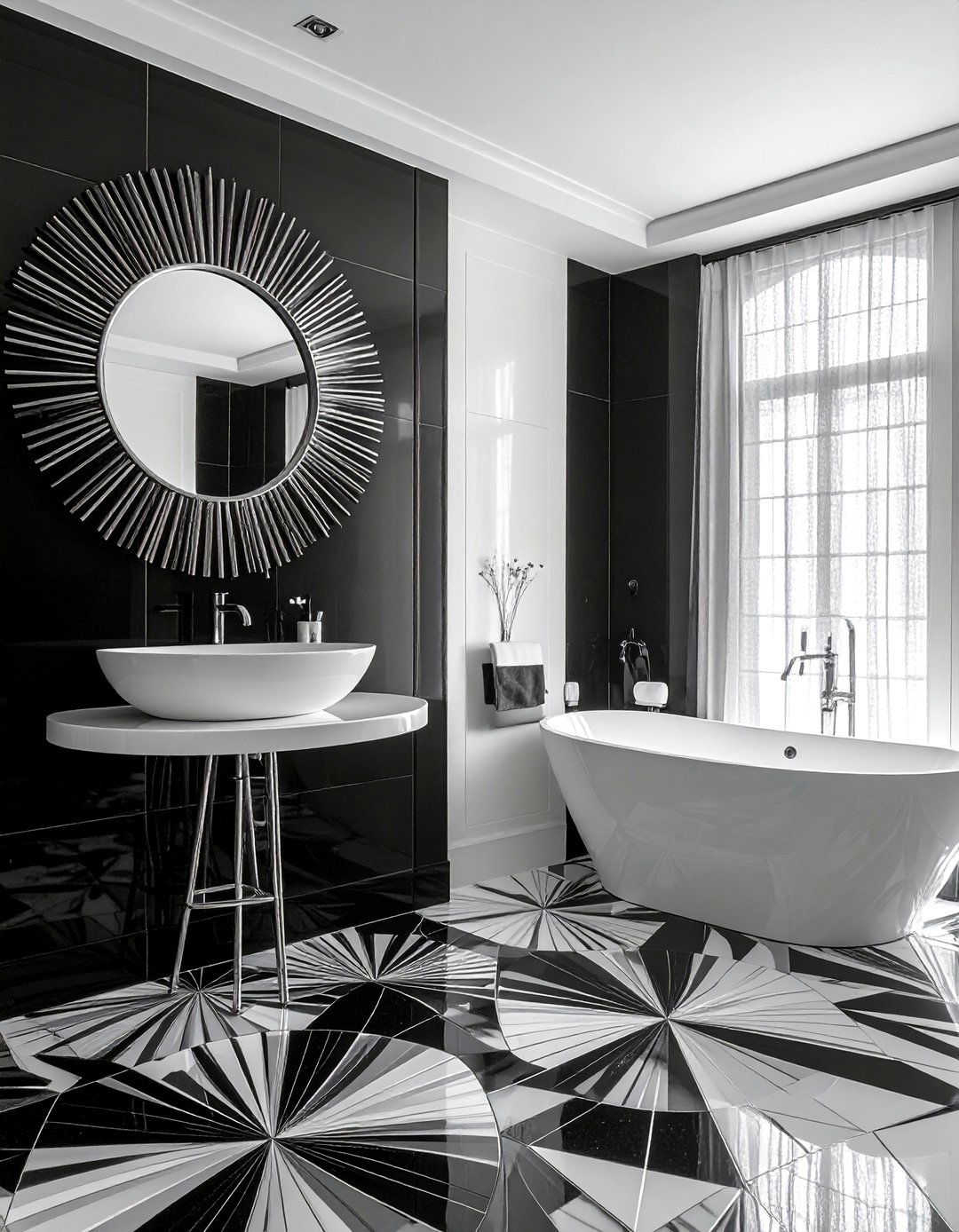
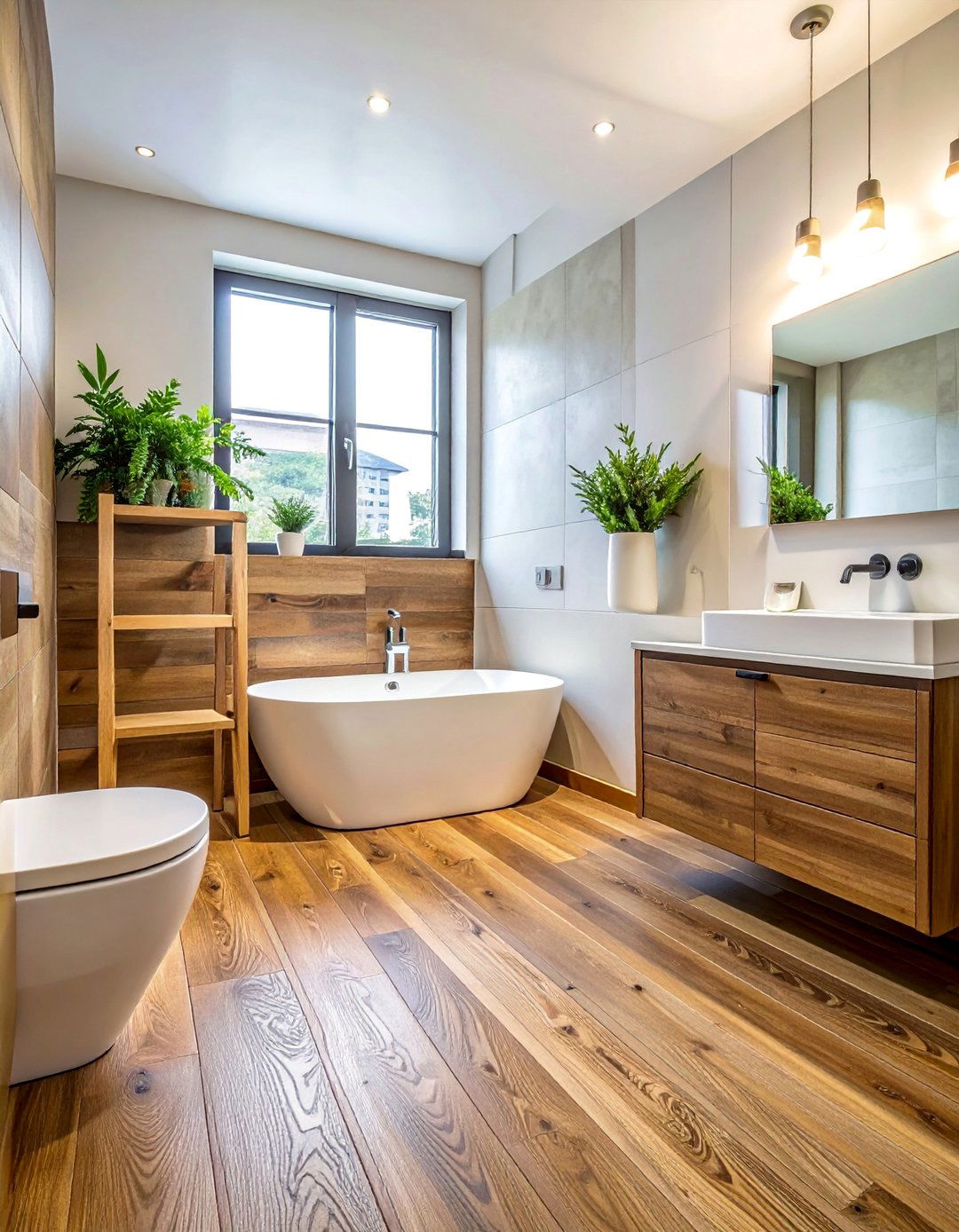
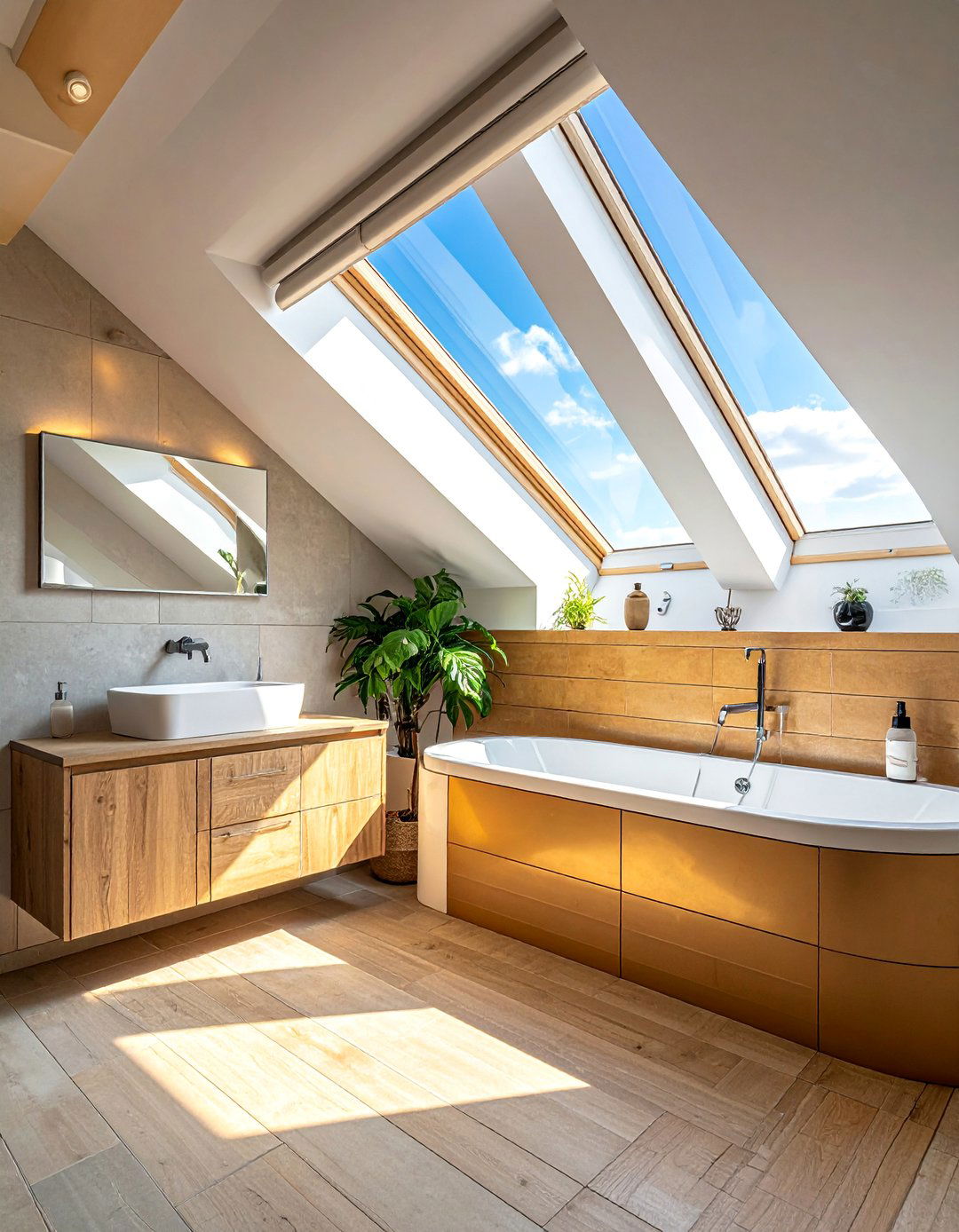
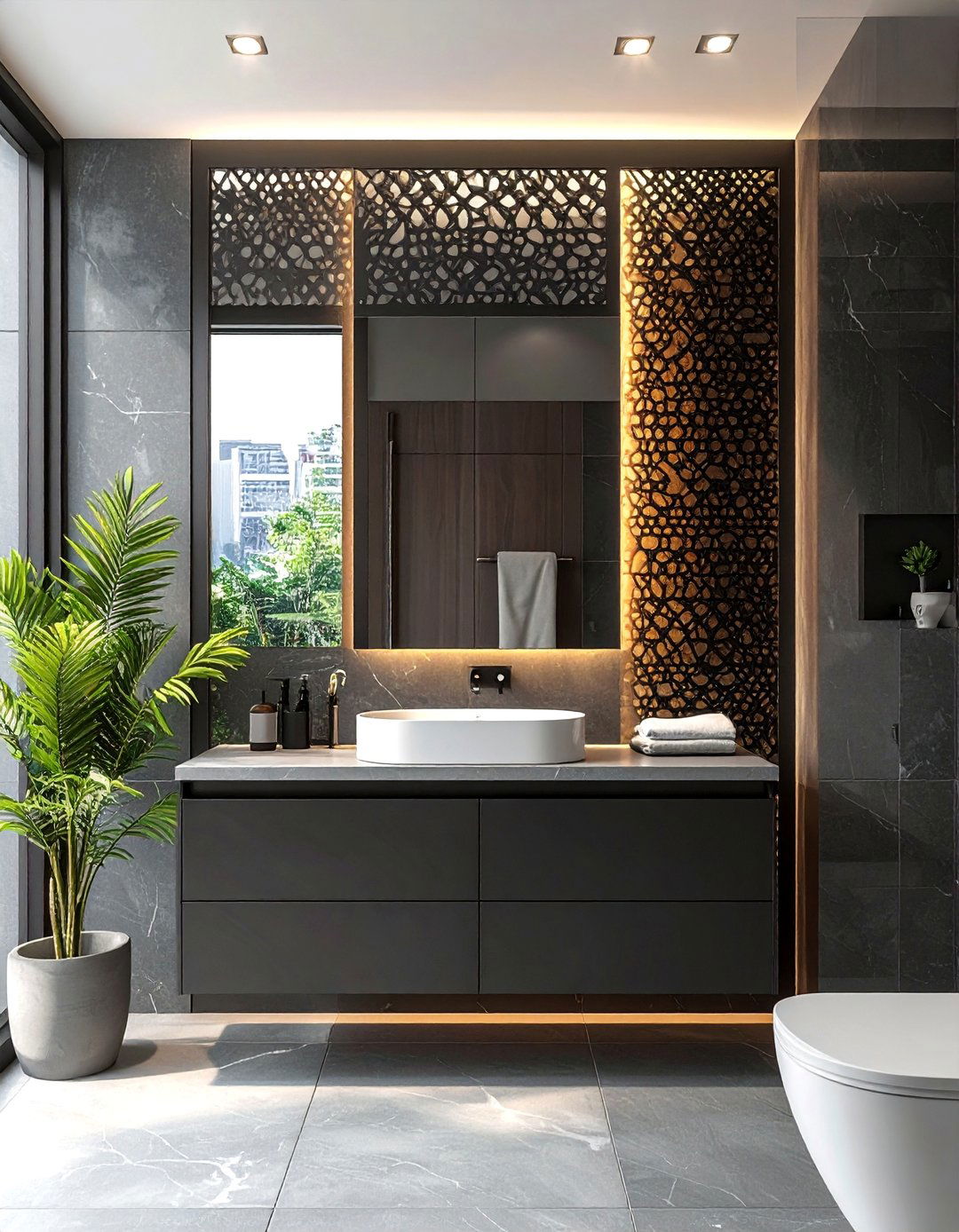
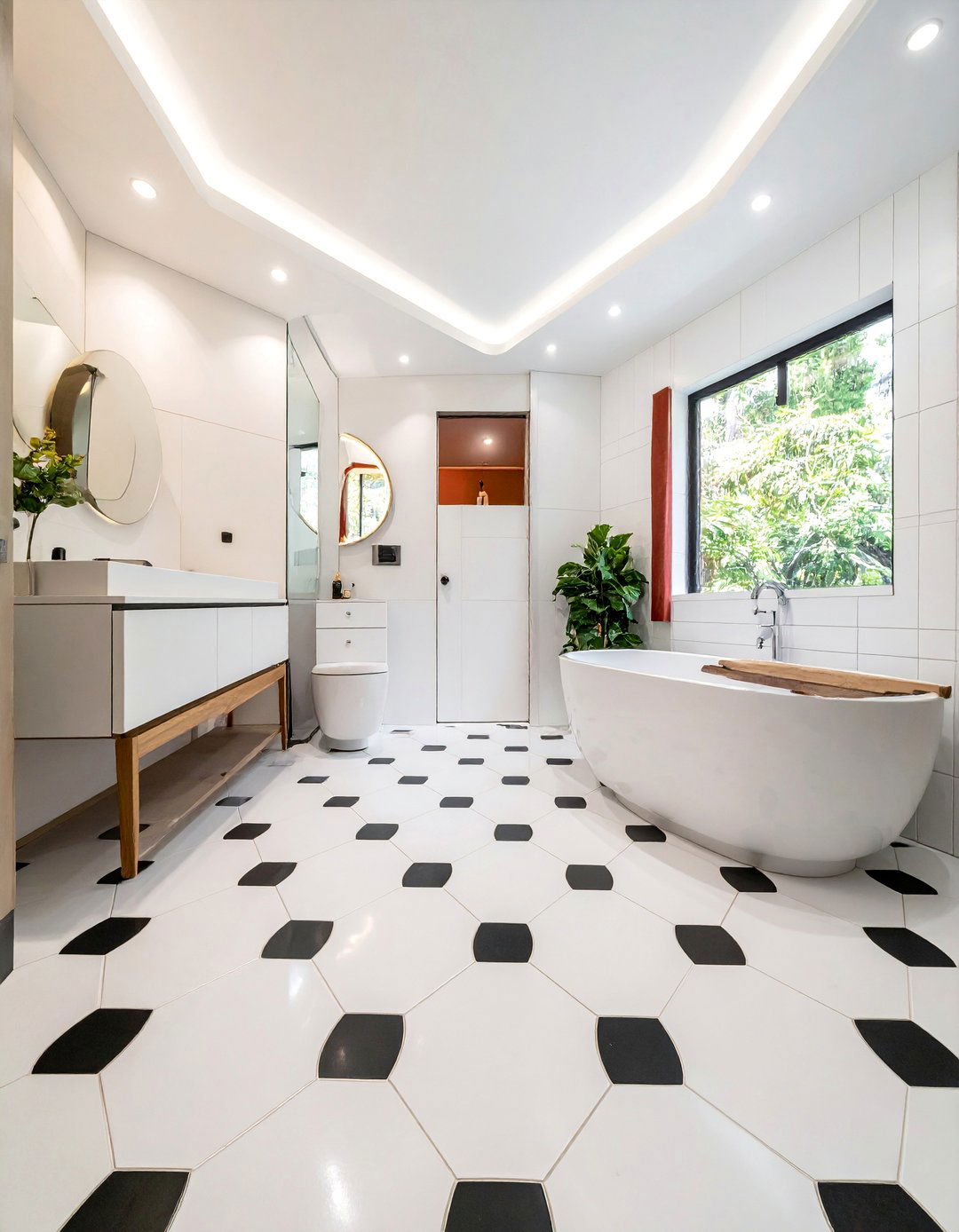
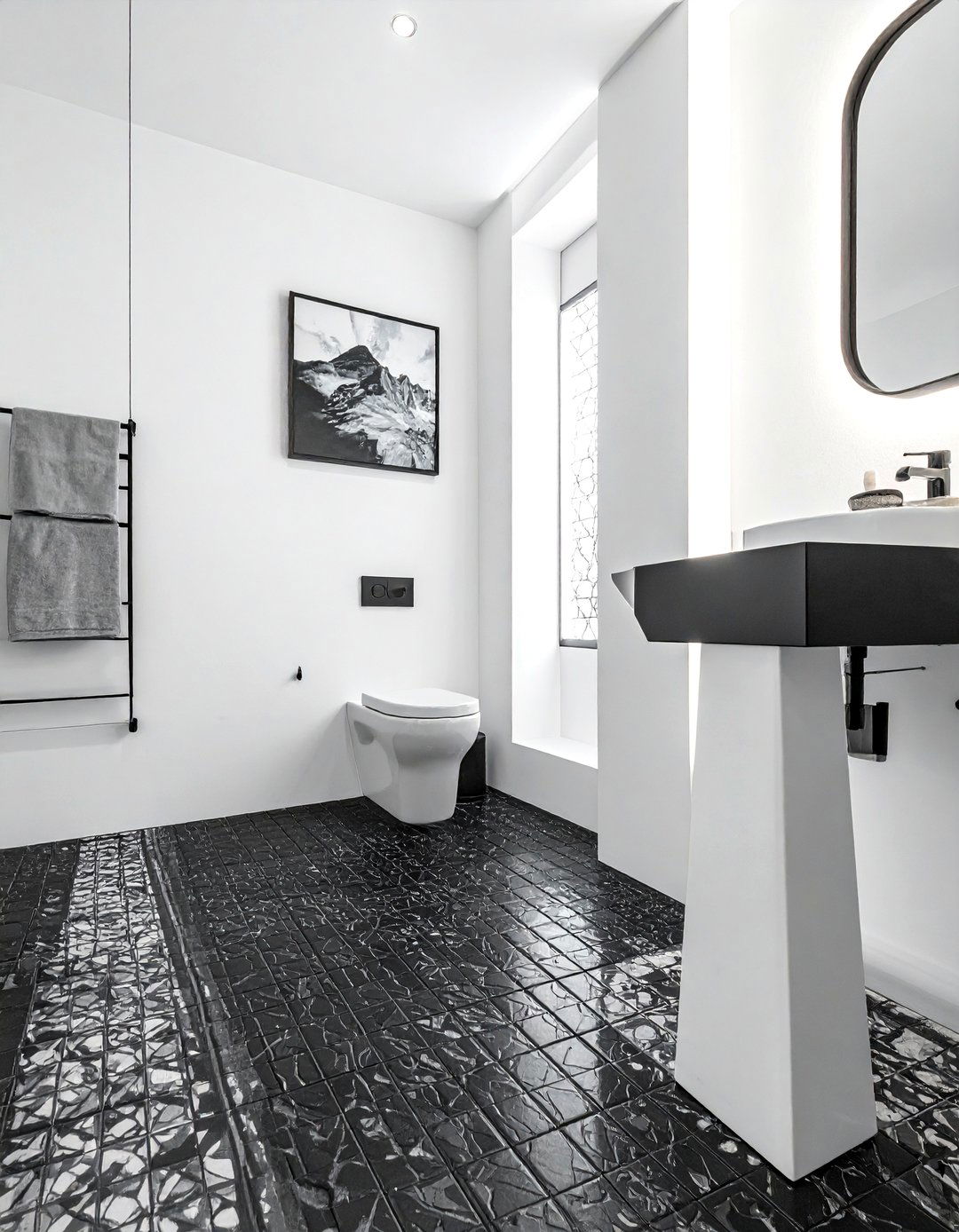
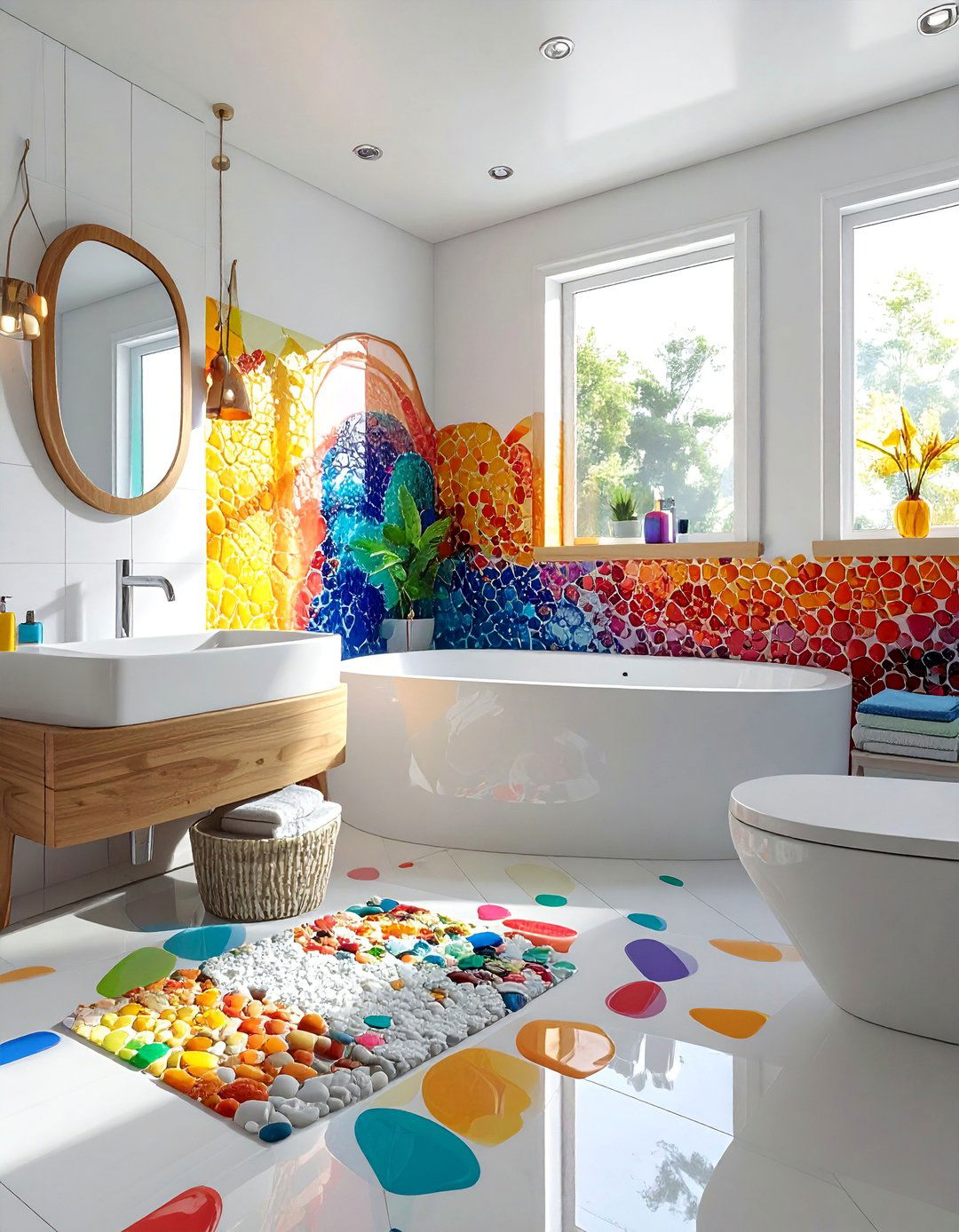
Leave a Reply